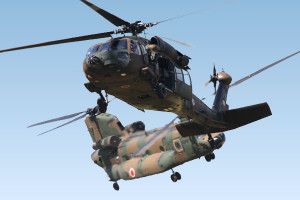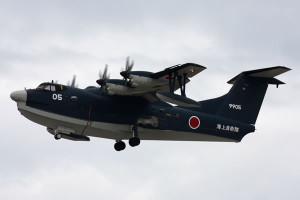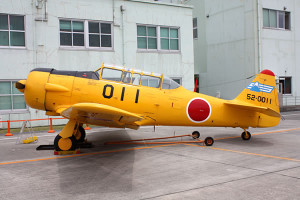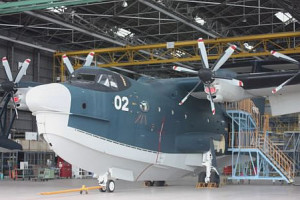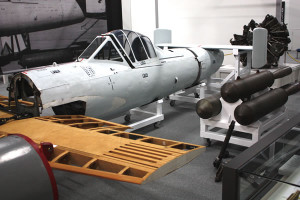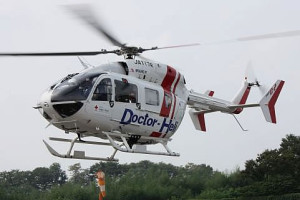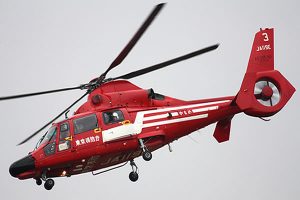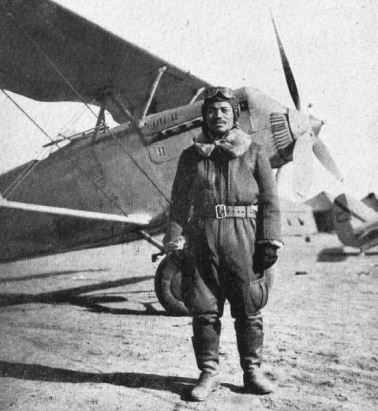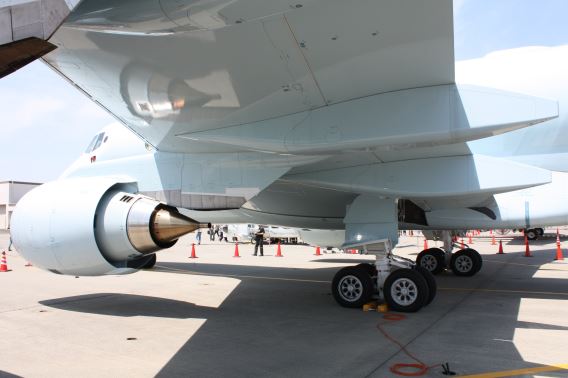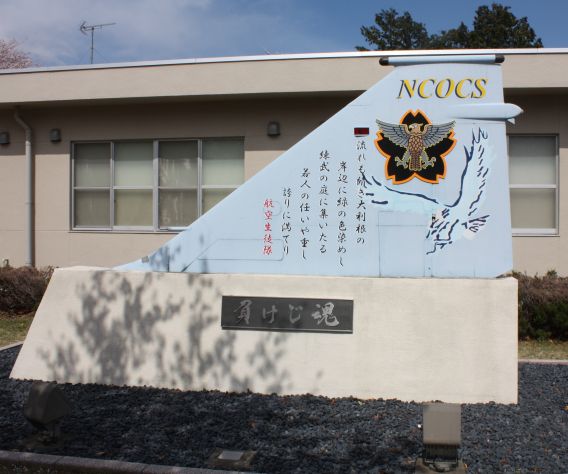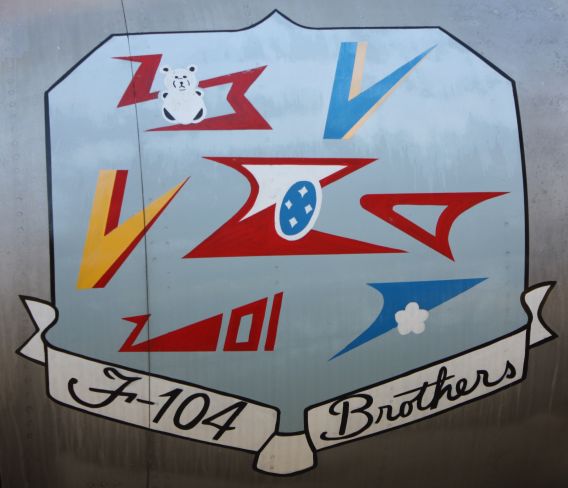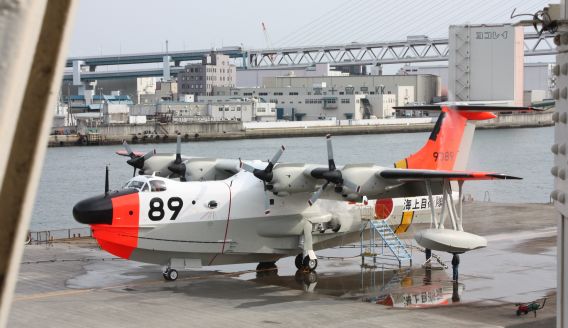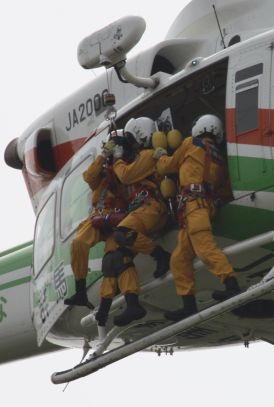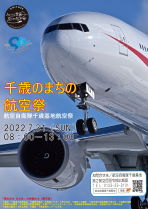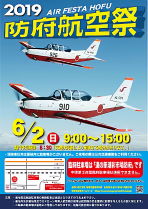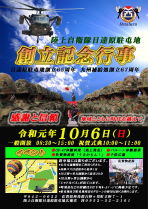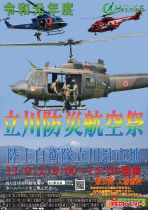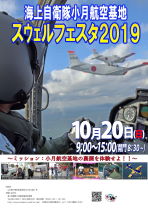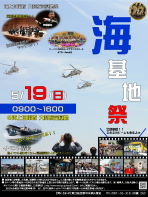Location Reports
Thus far, J-HangarSpace has filed reports from the following locations:
Pacific War Museum, Hagatna, Guam
Tokyo Heliport (see below for details)
Japan Coast Guard Haneda Air Station, Tokyo
Japan Ministry of Defense, Ichigaya, Tokyo
U.S. Naval Air Facility Atsugi, Kanagawa Prefecture
(including Kawasaki P-1 walkround)
JASDF Kumagaya Air Base, Saitama Prefecture
ShinMaywa Industries Ltd.’s Konan Plant, Kobe, Hyogo Prefecture (US-1A)
JGSDF Asaka Training Area, Saitama Prefecture
Gunma Heliport, Maebashi, Gunma Prefecture
ShinMaywa Industries Ltd.’s Konan Plant, Kobe, Hyogo Prefecture (US-2)
(All photographs on this website are copyright J-HangarSpace
unless otherwise stated.)
Location Report 10
Pacific War Museum, Hagatna, Guam
January 2020
 Among the Japanese collection on display is this windscreen from a Kawasaki Ki-100 fighter,
Among the Japanese collection on display is this windscreen from a Kawasaki Ki-100 fighter,
which is described as being from an aircraft that was shot down over Guam during
U.S. operations to retake the island in 1944.
Not to be confused with the somewhat more grandiose War in the Pacific (T. Stell Newman) Visitor Centre outside Naval Base Guam, the small, privately run Pacific War Museum is located close to the War in the Pacific National Historical Park. The facility was established in May 2001 by U.S. Marine Corps Vietnam veteran John Gerber, who developed and managed the facility right up to the time of his death in May 2010.
The museum’s narrow buildings (actually two recycled passenger jetways from Guam’s airport) provide a good opportunity to get up close and personal to an interesting collection of memorabilia; the corridor formed by one is devoted to American, the other to Japanese exhibits. Perhaps the most evocative non-military photo is that of the crowded beach at Tumon Bay taken in July 1945, a year after Guam’s liberation, when the U.S. military presence numbered more than 250,000.
Background to Conflict
The initial Japanese presence in Micronesia stemmed from the country’s participation on the Allied side in World War I, after which the previously German-held South Sea Islands north of the equator were ceded as mandated territories to the rising Asian power. Initially ruled by the Navy, their administration passed to a civilian agency, the South Sea Bureau, in 1922. Predating those events by some margin, the United States had received Guam as part of the spoils of the Spanish-American War of 1898.
Japan’s surprise attack against Pearl Harbor, on December 8, 1941, involved the sending of a carrier fleet halfway across the Pacific Ocean. In contrast, the simultaneous attack on the vulnerable outpost that was the U.S. Territory of Guam was launched from the Ogasawara (Bonin) Islands, 850 miles (1,370 km) distant.
A ground force from neighbouring Saipan, then a territory legally mandated to the Japan a mere 120 miles (190 km) away, linked up with the main strike force, which had moved from Korea to the Ogasawaras the previous month. After initiating the attack, the 6,000-strong attacking land force rapidly overwhelmed the 550 defenders, and Guam was fully in Japanese hands two days later.
Borne out by reports that there were never more than nine aircraft attacking at any one time, the Japanese relied upon shipborne floatplanes for air attacks against such a lightly defended target. The four heavy cruisers (the Aoba, Furutaka, Kako and the Kinugasa), the minelayer Tsugaru that made up part of the battle fleet could each carry up to two floatplanes, and the seaplane tender Kiyokawamaru was also in attendance.
 The cruiser Kako in Tokyo Bay in 1928, two years after she was commissioned and 13 years before
The cruiser Kako in Tokyo Bay in 1928, two years after she was commissioned and 13 years before
her participation in operations to capture Guam in December 1941. Her career was to be brought
to an end when sunk by a U.S. Navy submarine near Simberi Island, off what is today
Papua New Guinea, in August the following year. (Photo via Wikimedia Commons)
 Believed to have been taken in November 1941, this close-up of the stern section of the Kako shows
Believed to have been taken in November 1941, this close-up of the stern section of the Kako shows
two Kawanishi E7K2 (Alf) floatplanes mounted on the catapults. (Photo via Wikimedia Commons)
For the first two years of the Japanese occupation, efforts were focused on Guam becoming a source of staple crops and raw materials in support of the war effort. It was only when the tide of the war turned decidedly against the Japanese that the building of additional fortifications, including airfields, started to take precedence.
Museum’s Aviation Content
Poignantly, the museum is located on the hallowed ground called Nimitz Hill, close to Asan Beach, where U.S. Marines first came ashore when the invasion was launched on July 21, 1944. Encountering intense opposition, it was to be a week before they secured the beachhead—another landing on Agat Beach to the south was established after four days’ fighting—and another two weeks before they finally succeeded in bringing the Japanese occupation to an end, on August 10. The U.S. content naturally plays tribute to the 1,548 Marines who gave their lives during those operations.
Primarily comprising a collection of military vehicles inside and outside, the only aircraft relics from the Japanese occupation displayed outside are the tail section and Mitsubishi Kinsei engine, complete with two of its three propeller blades, from a Navy Aichi D3A (Val) dive bomber.
 J-HangarSpace is attempting to find out the back story about how this Val came to end up
J-HangarSpace is attempting to find out the back story about how this Val came to end up
at the Pacific War Museum on Guam.

 Hard to imagine by looking at this, but the Kinsei series of engines fitted as standard to the
Hard to imagine by looking at this, but the Kinsei series of engines fitted as standard to the
Val could be usually be relied upon to produce around 1,000 hp for takeoff.
 Two boys happily ride a water buffalo past an Army Type 2 Fighter (Nick) that was flown by a unit
Two boys happily ride a water buffalo past an Army Type 2 Fighter (Nick) that was flown by a unit
that has yet to be identified. The location is Tiyan, which was given the name Tomioka airfield by
the Japanese and the second built by them on Guam. A display that provides an order of battle
makes no mention of the presence of any Army air elements at the time of the U.S. invasion.
 Sumay, circa late 1945
Sumay, circa late 1945
A close look at another image (above), showing the effects of U.S. air raids on the town of Sumay, reveals the upturned floats of what is most likely a wrecked Aichi E13A (Jake); another wreck makes an unusual subject for a postcard after having been lifted from the water [link]. The arrival point for weekly Pan American’s China Clipper flying boat services, which had linked San Francisco and Shanghai via Hawaii, Midway, Wake and Guam and Manila from 1935, Sumay’s dual role as a shipping hub and communications centre placed the area high on the list of targets to come under Japanese air attack on December 8, 1941.
Not surprisingly, the location at Sumay on the Orote peninsula was eventually utilized by the Japanese for an air base, although as this had been a U.S. naval station and stopping-off point for civilian flying boats an airfield for land-based operations (known to the Japanese as Suma rather than Sumay) still had to be constructed. The Japanese Administration of Guam, 1941–1944 by Wakako Higuchi (published by McFarland, 2013) contains an eyewitness testimonial from one Satomi Yamamoto, who at age 18 was a civilian employee with a naval construction battalion. Having arrived on Guam on the last day of October 1943, he was assigned to an airfield runway construction detail.
Along with a second airfield at Tiyan (Tomioka), work at Sumay had for the most part been completed between by late February to early April 1944. Work to build two more airfields, at Dededo (Hiratsuka) and Barrigada (Haruta), was started in late April and early May 1944, a matter of weeks before U.S. forces moved to retake Guam.
Back at the Yamamoto account, mention is also made of a naval air group flying the Yokosuka P1Y Ginga (Frances) bomber (actually the 521st Otori [Phoenix] Air Group) that arrived during his time there. Originally formed at Chitose on Hokkaido with 24 D4Y Suisei (Judy) and four Ginga in August 1943, the 521st was only flying the latter type at the time of its arrival on Guam in April 1944 and went on to also operate a detachment from the island of Yap.
 The Shinji Morimoto exhibit
The Shinji Morimoto exhibit
Undated then and now photo exhibits show Shinji Morimoto (above), who while serving as a young mechanic, ostensibly on Mitsubishi G4M (Betty) bombers, with the 521st was allowed to flee into the jungle with a large group of comrades to await rescue when the U.S. advance threatened their area. He and the other survivors surrendered 10 months later. (Guam is where one Japanese soldier, Shoichi Yokoi, famously remained in hiding, oblivious that the war had ended, for 27 years.) The Morimoto exhibit includes a photo (below) of a Betty bomber captioned as being from the 521st as the number ‘521’ can be clearly seen on its tail, but this would appear to be a coincidence as aircraft from the 521st carried the tail code ‘21’ when in theatre. The three white fuselage bands ahead of the tail signified the aircraft assigned to the leader of the unit’s third section.
A panel that provides an order of battle and estimated strength for July 21, 1944, the day the U.S. forces commenced their invasion, lists the 800-strong 263rd “Panther” Naval Air Group under a Commander Tamai and the 755th Genzan (the Japanese name for Wonsan, Korea) Naval Air Group (700 men under Cdr Kusumoto), both of which flew the Zero fighter, as well as the 521st with 500 men under Cdr Kamai. The estimated grand total for Army and Navy units is 18,500 men.
Departing Shot
 Dawn Operations by Robert Taylor, mounted on a wall of the Clippers Lounge,
Dawn Operations by Robert Taylor, mounted on a wall of the Clippers Lounge,
A. B. Won Pat International Airport, Guam.
Anyone interested in aviation history should also visit the Clippers Lounge in the departure gate area of Guam’s A. B. Won Pat International Airport, which was built on the former site of the second airfield built by the Japanese, at Tiyan. The bar has a great collection of photos on the walls, ranging from the Pan American flying boat services, from which it takes its name, to jet fighters from around the world. Pride of place is given to a painting, entitled Dawn Operations, of a Type 0 (Pete) floatplane and two Zero fighters by the well-known British artist Robert Taylor. The painting bears the signatures of Second Sub-Lieutenant Sadaaki Ohnishi, who flew the Pete, and two former Zero pilots, Toyomi Toyoshima and Keiyu Takakuwa, who served with the Tainan and 203rd naval air groups, respectively.
 In prewar times, Apra Harbor and the then village of Sumay served as a refueling stop for
In prewar times, Apra Harbor and the then village of Sumay served as a refueling stop for
Pan American Clipper services operated on flying boats such as this Sikorsky S-42.
(Photo via Wikimedia Commons)
Location Report 9
Tokyo Fire Department Aviation Unit, Koto Aviation Center
Tokyo Metropolitan Police Department Aviation Unit, Koto Flight Center
Aero Asahi Corporation
Tokyo Heliport
February 8, 2017
 The view across the wide expanse of Tokyo Heliport apron from the roof of the
The view across the wide expanse of Tokyo Heliport apron from the roof of the
Aero Asahi Corporation hangar building
J-HangarSpace was again fortunate to be able to join an organized group visit that provided a rare opportunity to look behind the scenes/hangar doors at two long-term Tokyo Heliport residents:
- Tokyo Fire Department Aviation Unit, Koto Aviation Center
- Tokyo Metropolitan Police Department Aviation Unit, Koto Flight Center
- Aero Asahi Corporation
All possess facilities that would be the envy of the Japan Coast Guard personnel working in their by comparison somewhat dated abode across Tokyo Bay at Haneda Air Station, the subject of the previous report.
 The main Tokyo Heliport building as it looked in early April 2011, the month before its completion.
The main Tokyo Heliport building as it looked in early April 2011, the month before its completion.
(Nesnad via Wikimedia Commons)
NOTE: Despite the lack of a checkpoint or any warning notices, security considerations prohibit even outside photography when on Tokyo Heliport premises. J-HangarSpace is thus unable to open this report with an uncluttered photo of the main building and control tower, taken on the day before the restriction was made clear just a few yards away from the public highway. For the same reason, the report of the visit to the Tokyo Metropolitan Police Department Aviation Unit’s Koto Flight Center includes no photographs taken on TMPD premises. (It thus came as an unexpected privilege to later be allowed to photograph from the roof of the Aero Asahi facility, which is adjacent to that same heliport building.)
Tokyo Heliport
In a scenic location overlooking Tokyo Bay, the current Tokyo Heliport opened 45 years ago, on June 15, 1972, replacing a facility at nearby Tatsumi that had been operational since 1964. Having undergone gradual expansion from 1990 onward, a new management building and control tower was completed in May 2011. Currently utilized by around 100 companies, the thriving heliport provides employment for more than 800 people. The apron has no less than 38 helicopter pads, 10 of which can accommodate larger types.
- Tokyo Fire Department Aviation Unit, Koto Aviation Center
The first port of call on the tour was the Tokyo Fire Department (TFD) Aviation Unit, the distinctive red aircraft of which are a familiar sight in the skies over and around Tokyo.
The TFD facility at Tokyo Heliport is officially referred to as the Koto Aviation Center, after the name of the Tokyo ward in which the heliport is located. Its sister facility, the Tama Aviation Center, commenced operations in September 1994 and is likewise co-located with a police unit at JGSDF Tachikawa Army Camp in west Tokyo. In recent years, the TFD Aviation Unit has benefited from funding that permitted the acquisition of two new helicopters in 2014 and, in October 2015, the renovation and reconstruction of its Koto Aviation Center building.
From its two bases the TFD Aviation Unit currently operates a total of eight aircraft, divided exactly between the medium (Dauphin) and large (Puma) classes of helicopter. The first of its kind in Japan, the unit commenced operations from Tatsumi with a Sud-Aviation Alouette III exactly 50 years ago, in April 1967. Since then, the TFD has remained brand loyal to the French manufacturer through its name changes, from Aérospatiale and Eurocopter to what is now Airbus Helicopters. Both classes of helicopter are a mix of one earlier version (AS365N2, AS332L1) alongside three examples of a later version (AS365N3; EC225LP, now known as the H225). The unit notched up 60,000 accident-free flying hours in October 2007; the 70,000-hour mark was passed in September 2012.
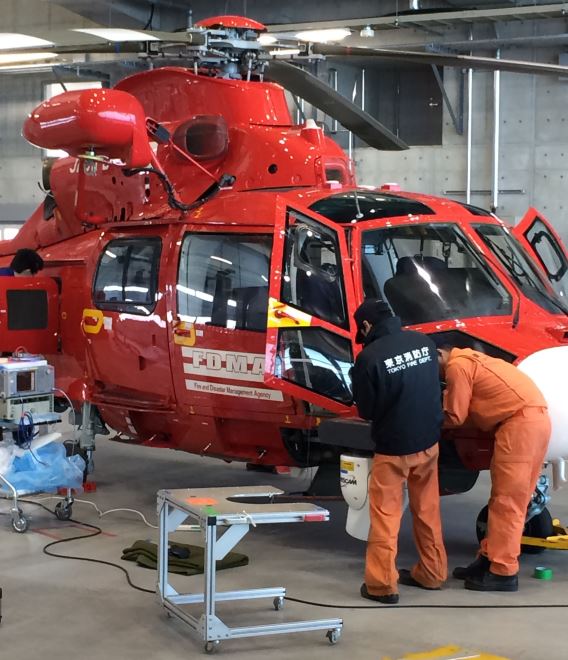 One of the three AS365N3s in service with the TFD Aviation Unit, Ootaka (Goshawk) has the turret
One of the three AS365N3s in service with the TFD Aviation Unit, Ootaka (Goshawk) has the turret
containing its L3-WESCAM 36x magnification camera and video transmission system
refitted after maintenance.
The TFD’s fiscal 2017 budget includes two items under an allocation of 601.1 million yen for the “upgrading and improvement of aerial firefighting systems”: a replacement for the AS332L1, to be recorded under the fiscal 2019 budget to ease Tokyo’s debt burden, and the supply of spare parts to upgrade the AS365N2.
In terms of total numbers of personnel, the unit comprises 26 pilots, 38 maintenance personnel and 21 administrative support staff members.
Present in the TFD hangar at the time of the visit were one example of each of the two newer classes of helicopter operated, an AS365N3 and an EC225LP.
Overview of Operations
From its two bases, the TFD undertakes the full gamut of the operations that would be expected of an airborne firefighting unit in Tokyo.
An obvious priority is placed on preparedness to respond to and deal with major residential fires, be they in the older parts of the city or in modern high-rise apartment buildings. The belly tanks on the unit’s EC225LPs hold 2,700 litres and can be refilled while hovering over a lake or river. When combating a building fire, 600 litres of water (or foam) a minute can be discharged via a swiveling, side-mounted boom that is around 7 metres long and has a range of 30–40 metres. An example of this type of system, the Simplex Model 516 High-Rise Firefighting System or SkyCannon, gained Japanese authority certification and was tested by the unit on an EC225LP in September 2015.
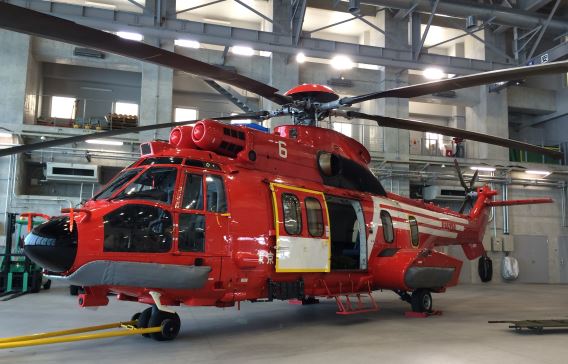 Also present in the TFD Aviation Unit hangar was Hakuchō (Swan), one of the two EC225LP helicopters
Also present in the TFD Aviation Unit hangar was Hakuchō (Swan), one of the two EC225LP helicopters
that entered service in the spring of 2014 as part of a fleet upgrade. The black mounting on the side of
the fuselage is for a Simplex SkyCannon firefighting boom.
Should any forest fires break out in the areas around Tokyo, all 2,700 litres of water can be dropped directly from the belly-mounted tank in one salvo; the same FireAttacker tank fitted to the smaller helicopters holds 900 litres. Information gathered and images taken at the scene of any incident can be relayed back to base in real time for prompt assessment.
As and when needed, the capital’s helicopters are ideally located to support local prefectural aviation units, the cities of Mito in Ibaraki Prefecture, Utsunomiya (Tochigi), Kofu (Yamanashi) and Mishima (Shizuoka) being just over 20 minutes’ flight time away. In September 2014, the Aviation Unit was deployed to Nagano Prefecture following a catastrophic volcanic eruption on Mt. Ontake, only to return two months later when the northern part of the prefecture suffered a major earthquake; these two disasters alone claimed a total of nearly 100 lives.
On March 11, 2011, the Aviation Unit was naturally immediately called upon following what became known as the Great East Japan Earthquake, which triggered tsunamis along Japan’s northeastern coastline. The three aircraft that were airborne at the time returned to base, two of them being rapidly relaunched to provide initial assessments of any damage suffered in the Tokyo area. Then deployed further afield, the unit remained heavily involved in coordinated operations in the disaster-affected areas of the Tohoku region until May 13, a total of 64 days.
 On its main cabin doors, JA01FD Ootaka also bears the name and initials of the organization to which it is officially registered, the Fire and Disaster Management Agency (FDMA) that reports to the Ministry of Internal Affairs and Communications. Also carrying the TFD logo (below) on its tail, the aircraft officially joined the Aviation Unit’s ranks at a ceremony held at the Tama Aviation Center
On its main cabin doors, JA01FD Ootaka also bears the name and initials of the organization to which it is officially registered, the Fire and Disaster Management Agency (FDMA) that reports to the Ministry of Internal Affairs and Communications. Also carrying the TFD logo (below) on its tail, the aircraft officially joined the Aviation Unit’s ranks at a ceremony held at the Tama Aviation Center
in Tachikawa on March 23, 2006.
 (via Wikimedia Commons)
(via Wikimedia Commons)
Taken at Tokyo Heliport in May 2014, a YouTube video of AS365N3 JA01FD can be viewed here [link].
Overwater domestic operations extend out to the Pacific Ocean islands administered by the Tokyo Metropolitan Government. These operations typically involve the airlifting of medical cases from Izu-Oshima, also just over 20 minutes by helicopter, or Aogashima, around 90 minutes away. Recent years have also seen the unit coming to inhabitants’ aid in response to a volcanic eruption on Miyake Island (2012) and landslides on Izu-Oshima (2013).
Even further afield, personnel and helicopters are sent overseas as part of Japan’s contribution to international responses to natural disasters. In the other direction, delegations from other Asian countries have visited Tokyo to witness first-hand and learn from the Aviation Unit’s operations and techniques.
Other than the practice of waterbombing techniques, regular training exercises involve hoist rescues, the lifting of underslung loads and familiarization with new equipment. The latter includes a special underslung rescue gondola, with capacity for up to 15 people, designed for use in rapid, high-capacity evacuation situations, such as tsunamis and high-rise building fires.
 The hoist fitted to the EC225LP has a 272kg load capacity, the same as the AS365N3. At 3.8 metric tons,
The hoist fitted to the EC225LP has a 272kg load capacity, the same as the AS365N3. At 3.8 metric tons,
its underslung load-carrying capacity is more than double that of the smaller aircraft’s 1.6 metric tons.
Joint training exercises aim to fine tune close collaboration with other prefectures as well as with other services and agencies, such as Self-Defense Force (SDF) and Japan Coast Guard units.
Tokyo Fire Department Aviation Unit Helicopter Responses (Past Five Years)
(Data kindly supplied by Tokyo Fire Department, Feb. 2017)
| Fire | EMS | Dis’r* | Drill | Inv* | Patrol PR |
Test | Trng* | Edn* | Other | Total | |
| 2012 | 81 | 425 | 64 | 46 | 54 | 3 | 282 | 476 | 93 | 74 | 1,598 |
| 2013 | 102 | 442 | 92 | 40 | 25 | 4 | 316 | 363 | 124 | 59 | 1,567 |
| 2014 | 66 | 430 | 74 | 23 | 59 | 5 | 275 | 400 | 209 | 58 | 1,599 |
| 2015 | 35 | 343 | 37 | 23 | 20 | 6 | 229 | 497 | 159 | 42 | 1,391 |
| 2016 | 35 | 391 | 48 | 35 | 24 | 6 | 244 | 639 | 54 | 39 | 1,515 |
| Total** | 4,795 | 10,015 | 2,444 | 1,897 | 2,798 | 3,438 | 8,612 | 12,236 | 4,444 | 3,887 | 54,566 |
(*) Dis(aste)r, (Inv)estigation, Tr(aini)ng, Ed(ucatio)n
(**) Cumulative total since 1966
Hyper Active
Established under the TFD Aviation Unit in a ceremony on the day of the traditional Tokyo Fire Department New Year parade on January 6, 2016, the 44-man Air Fire Rescue Task Forces—also referred to as Air Hyper Rescue—are divided into two elite teams, one specializing in rescue, the other emergency medical services (EMS). Both are primarily based at the Koto Aviation Center, with a detachment at the Tama Aviation Center.
One area of expertise for the new unit is the mounting of rescues from high-rise buildings, which are defined as having 11 floors or more, in other words above the height reachable by a TFD fire engine ladder. In June 2015, The Japan Times reported that the number of such properties in the capital stood at around 12,500 and was steadily growing, and that 2013 had seen 83 fires break out above the 11th floor, almost double the figure for 2003. In May 2016, there were 13 projects for residential properties of 50 floors or more. If you factor in the difficulties of road access and the likelihood of fire hydrant damage in an earthquake, maintaining an airborne option is essential.
On March 1, 2016, the multilateral approach was put to the test when three Aviation Unit helicopters and Air Hyper Rescue personnel participated in a large-scale training drill as part of a firefighting festival held in the Shinagawa area of downtown Tokyo. Designed to raise and maintain public awareness of fire prevention, around 150 TFD and SDF personnel took part in the drill. The setting assumed that a fire had broken out in the Sea Fort Square Center Building, a 23-storey office block that forms part of a complex of shops, offices and residences. Including some fine shots of Hakuchō “in action” with its SkyCannon firefighting boom, a selection of photos from the event can be found here [link].
The Aviation Unit has now added regular training to minimize the time taken to position the Air Hyper Rescue early response vehicle on a special platform for safe airlift to the site of any disaster.
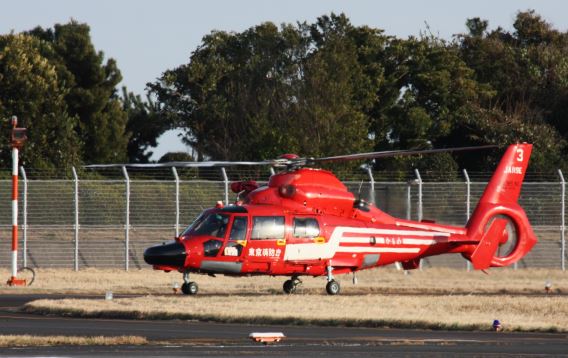 AS365N3 JA119E Kamome (Seagull) came home to roost later in the afternoon. This aircraft has been
AS365N3 JA119E Kamome (Seagull) came home to roost later in the afternoon. This aircraft has been
in service with the TFD Aviation Unit since March 2009. The odd man out medium-sized helicopter in
the fleet is a 1997-vintage AS365N2.
| TFD Aviation Unit Disaster/EMS Response Statistics for 2015* | |||
| Fires | 35 missions | EMS Responses | 263 people (343 missions) |
| Rescues | 21 people (30 missions) | Remote Islands | 210 people (228 missions) |
(*) The most recent year for which figures are available.
Source: Sora no Shōbō [Aviation Fire Service], a brochure provided by the TFD Aviation Unit
 Part of a publicity poster for the Air Fire Rescue Task Forces, also referred to as Air Hyper Rescue,
Part of a publicity poster for the Air Fire Rescue Task Forces, also referred to as Air Hyper Rescue,
displayed in the TFD Koto Aviation Center building entrance. On the right is a citation, signed
by Shigeo Matsukawa, the head of the TFD Administration Division, commending the unit for
its performance at the March 2016 training drill mentioned in the text.
• Tokyo Metropolitan Police Department Aviation Unit, Koto Flight Center
Modern-day police work the world over benefits greatly from the helicopter’s mobility and rapid response capabilities. Operations in the Tokyo metropolitan area fall broadly into four categories: patrols, including traffic surveillance; searches, be they for accident survivors or crime suspects, including the use of forward-looking infrared radar (FLIR); rescue missions; and information gathering at the scene of any incidents.
From humble beginnings with a Bell 47G-2 named Harukaze (Spring Breeze) in October 1959, the Tokyo Metropolitan Police Department (TMPD) Aviation Unit currently operates 14 helicopters, not surprisingly making the unit by far and away the largest of its kind in the country. By way of comparison, in other parts of the country much depends on the size of the prefecture’s population and budget: most operate only one helicopter, likewise densely populated Osaka has seven, while Hokkaido has five aircraft to cover an expanse the size of Austria.
Reporting to the National Police Agency (NPA), the TMPD officially formed its Aviation Unit in April 1964 and has operated nearly 40 rotorcraft in its time. The only exception was the somewhat more sedate Airship Industries Skyship 600 airship, which was also bestowed with the name Harukaze and remained in service from March 1989 to March 1994. During this time, its slow-moving bulk lent itself well to the additional use as an airborne billboard, here [link] urging the populace’s cooperation in criminal investigations.
To simplify the coordination of operations, the TMPD unit’s current aircraft share the same two base locations as the Tokyo Fire Department Aviation Unit: Tokyo Heliport (known to the police as the Koto Flight Center), where 18 pilots are based, and the Tachikawa Flight Center with 10 pilots. Although based in Tokyo, the TMPD unit’s operations are by no means confined to the capital, as deployments are mounted anywhere in the country when required; its back catalogue of participation in major disaster relief operations closely follows that of the TFD.
 One of three aircraft present in the pristine TMPD hangar at the time of the visit, AB139 Ootori 4
One of three aircraft present in the pristine TMPD hangar at the time of the visit, AB139 Ootori 4
joined the unit’s ranks in February 2006. Seen here at Tachikawa in November 2013, the aircraft
has since been equipped with a locally customized, side-mounted CineflexT14 camera.
Major operations unique to the capital include the monitoring of the Tokyo Marathon. The holding of the 2020 Tokyo Olympics and Paralympics at venues in and around the city will involve the drafting in of aircraft from surrounding prefectures as reinforcements. A case of TMPD aircraft moving in the other direction was the G7 Ise-Shima Summit in May 2016, which involved a massive police presence, in terms of helicopters as well as personnel, as had the G8 Hokkaido-Toyako Summit in July 2008.
A short video of fast cuts of TMPD Aviation Unit operations can be found on the TMPD website [link].
Whereas its Tokyo Fire Department sister service has remained loyal to what is now Airbus Helicopters Japan, the TMPD rang the bell on its initial provider and since the late 1990s has sourced its aircraft primarily from Europe. The only exception was the 2011 addition of a passenger transport-configured Sikorsky S-92 (see this 2016 YouTube [link]), which was undergoing maintenance at the time of the visit.
 Noticed making its way around to its parking spot was the TMPD’s sole Agusta (now Leonardo-
Noticed making its way around to its parking spot was the TMPD’s sole Agusta (now Leonardo-
Finmeccanica) A109E Power, Hayabusa 5. Following the order announced in June 2016, the
aircraft is to be joined next year by two of the updated AW109 Trekker version, which will be
the first of the type to be used for law enforcement purposes in Asia
Generally, TMPD pilots tend to be police officers who have passed suitability testing conducted by the Japan Ministry of Defense before acquiring business pilot qualifications at accredited organizations. Also drawn from police ranks, maintenance personnel holding at least a Class 2 aviation mechanic’s license are recruited following a selection process.
Traditionally taking disaster response and rescue operations in general as its theme, the airshow held at Tachikawa in autumn every year provides the Tokyo police and fire department air units with a golden opportunity to demonstrate their capabilities to the taxpaying public.
That first Bell helicopter remains on display at the Tokyo Metropolitan Police Museum, which is due to reopen after a year-long refurbishment this spring (2017).
 (From YouTube video by tomo306Jeans – see text below)
(From YouTube video by tomo306Jeans – see text below)
Showing Tokyo Heliport-based TMPD H155 Ootori 5 in flight, the above still is from a long but well-shot YouTube video of 19 police helicopters that took part in a training exercise at JGSDF Akeno in May 2016, just prior to the G7 Ise-Shima Summit. The video can be found here [link]; the H155 footage starts at around the four-minute mark.
• Aero Asahi Corporation
The last but not least stop on the tour was Aero Asahi Corporation (AAC), which bases not only its rotorcraft aviation business but also its corporate headquarters at Tokyo Heliport.
Founded in July 1955, the original company split its activities into fixed- and rotary-wing operations and accordingly changed their tradenames to Asahi Airlines Co. and Asahi Helicopter Co., Ltd., respectively, in September the following year.
The name Aero Asahi (Asahi Kōyō in Japanese) dates from the July 1, 1982, merger of Asahi Helicopter and the helicopter operations of Toyo Aviation (Tōyō Kōkū Jigyō, literally Oriental Air Enterprises), which had itself been founded in 1960. The two companies had been engaged in a business partnership since as early as July 1961.
Today part of the Toyota Motor Corporation group of companies, AAC is involved in all aspects of helicopter operations. The main focus of J-HangarSpace interest is the company’s major involvement in the nationwide Doctor-Heli EMS services. Another Doctor-Heli operator, Nagoya airport-based Central Helicopter Service, Ltd. (formerly Kawasaki Helicopter System Ltd.), which has been an Aero Asahi group company since March 2007, will be celebrating its 50th anniversary on March 10 this year.
In its own right, AAC operates a fleet of 15 helicopters configured for Doctor-Heli operations, eight BK117C-2s and seven MD902 Explorers. These currently provide EMS cover for 12 hospitals in 10 prefectures, from Asahikawa in Hokkaido to Kumamoto in Kyushu. (The data included on the Doctor-Heli Network page of this website will be expanded in due course.)
 At the time of the visit, two MD902s were receiving attention. The maintenance bays in the AAC
At the time of the visit, two MD902s were receiving attention. The maintenance bays in the AAC
hangar do not lend themselves well to photography from the designated walkways.
A short YouTube video [link] shows the aircraft below returning to base.

Parting Shots
 Seen from the roof of the Aero Asahi facility, AS365N3+ Sokokaze (Zephyr) 2, the 2015 addition to the
Seen from the roof of the Aero Asahi facility, AS365N3+ Sokokaze (Zephyr) 2, the 2015 addition to the
Kawasaki Air Rescue operation, is parked on its assigned spot on the apron. Although the city of
Kawasaki lies in neighbouring Kanagawa Prefecture, its firefighting aviation unit has been
a permanent Tokyo Heliport resident since the start of its operations in July 1985.
 The Agusta Westland AW139 operated for Japan Broadcasting Corporation (NHK) by All Nippon
The Agusta Westland AW139 operated for Japan Broadcasting Corporation (NHK) by All Nippon
Helicopters (ANH) since 2014 is towed out into the afternoon sun at Tokyo Heliport. Although
not currently part of J-HangarSpace coverage, a feature on the operations of the broadcast
news helicopters could well be added at some point. That’s the Tokyo Heliport-based
Kawasaki Air Rescue AS365N3+ again in the background.
Once again, J-HangarSpace is greatly indebted to Keiichi Akaboshi of the Japan Aircraft Pilot Association and Ken Yanai of the Japan Business Aviation Association for their not insignificant part in organizing what was a most enjoyable visit.
Getting There
The nearest train station to Tokyo Heliport is Shin-Kiba, on the JR Keiyo and Musashino lines, the TWR Rinkai Line (that connects directly with the JR Saikyo Line) and the Yurakucho Line on the Tokyo Metro network. From there, a 10-minute loop-line bus ride brings you to a stop in front of the main entrance, which only offers a view of a row of heliport buildings (plus see security note above). The favoured spots are from footpaths on the far side of the apron, as seen on this map from 2006 [link], and from Shin-Kiba Rokudo Park.
The Lie of the Land
Shot in July 2016, this YouTube video [link] gives a good idea of what can be seen from above the fence line, should you happen to have a ladder handy.
Timings relevant to this report:
Police H155 JA15MP 2:21; A109E JA34MP 6:44; AB139 JA14MP 9:00
Fire AS365N3 JA119G 10:38
As the video shows, the heliport is prone to strong winds—as evidenced, too, by the presence of a wind turbine in the area—and in summer the long grass can present an obstacle to more than just the birds for which it is intended to act as a deterrent.
To end with, a general view of the heliport complex can be gained from this October 2014 video [link], showing the arrival and departure of a Tokyo Fire Department EC225.
Location Report 8
Japan Coast Guard Haneda Air Station, Tokyo
November 11, 2016
 The view out through the doors of the JCG Haneda Air Station hangar. Note that the nearest helicopter,
The view out through the doors of the JCG Haneda Air Station hangar. Note that the nearest helicopter,
EC225LP Super Puma JA691A Inuwashi (Golden Eagle), lacks its main rotor.
The Japan Coast Guard (JCG) personnel at Haneda Air Station control all the air operations of the service’s 3rd Region, which is headquartered and homeported at Yokohama in neighbouring Kanagawa Prefecture. One of the 11 such regions into which Japan is divided for the purposes of monitoring and safeguarding its territorial waters, the 3rd’s normal land-based complement resident at Haneda currently comprises four specially equipped fixed-wing aircraft—two of the service’s nine Bombardier Dash 8-Q300s and both of its Gulfstream Aerospace GV Sea Watch aircraft—and two Airbus Helicopters Super Pumas, one of the earlier AS332L-1s and an EC225LP. Another two AS332L-1s are embarked on the Shikishima (PLH31) patrol vessel, with another pair of EC225LPs aboard the Akitsushima (PLH32). All four helicopters are naturally shore-based at Haneda when their parent vessels are in port.
A former Haneda resident, the service’s first AS332L-1 happened to be undergoing maintenance at Sendai airport in Miyagi Prefecture when the tsunami struck on March 11, 2011. Decommissioned three months later, the already 19-year-old aircraft was eventually refurbished in Canada and is currently being flown by a civil operator in Norway. The Bell 412EP previously based at Haneda was transferred to the 6th Region’s Hiroshima Air Station early in 2015.
At the time of J-HangarSpace’s visit, both of the GVs were absent and only one of the Dash 8s was present but undergoing maintenance and therefore off limits. Coincidentally, this aircraft also sustained damage after being caught in the March 2011 tsunami, but was eventually returned to service in March 2012.
 Tucked away in a corner with its cabin brimming with test equipment while undergoing maintenance
Tucked away in a corner with its cabin brimming with test equipment while undergoing maintenance
was Bombardier Dash 8-Q300 JA722A Mizunagi (Shearwater). Delivered early in 2009, the aircraft
remained out of service for just over a year after sustaining damage in the March 2011
tsunami at Sendai, Miyagi Prefecture.
Origins
The JCG can trace its origins back to May 1, 1948, during the Allied Occupation that followed the end of World War II, when the Maritime Safety Agency (MSA) was formed as a then extra-ministerial agency under the control of the transport minister to counter illegal activities, such as smuggling and acts tantamount to piracy, which were rife in postwar Japan. The regional organization officially came into being on January 1, 1962. Although retaining its Japanese name (Kaijōhoanchō), the MSA officially became the Japan Coast Guard on April 1, 2000, and reports to the Minister of Land, Infrastructure and Transport; the service’s senior officer bears the rank of commandant.
A fledgling aviation element was added to the service in 1953, when its first aircraft, a Kawasaki-Bell 47D-1 and a Sikorsky S-55, were commissioned at Tateyama, Chiba Prefecture, on July 12 and December 12, respectively. The first fixed-wing aircraft was a Beech E18S that arrived in March 1956. In July 1958, operations were relocated to Haneda Airport, where the current facilities were opened in August 1967.

The general administrative base operations support section and operational liaison and coordination sections are housed in seemingly cramped conditions on the floor above the hangar. It is here, too, that intelligence gathered from the aircraft is assessed. Japan is by no means alone in facing the problem of aging infrastructure. As the increased burden of responsibilities that have been placed on the JCG mean operations at Haneda have outgrown the space available, presumably there are contingency plans being made to replace or somehow upgrade and expand the facilities, when funding permits.
Extensive Area of Responsibility
A map on the 3rd Region’s website [link] helps to gain a better idea of the distances involved in operations that can and do extend to the nation’s easternmost and southernmost points. From a point running roughly due south from the coast as far west as the border between Shizuoka and Aichi prefectures, the demarcation line includes the 200 nautical mile (370km) exclusive economic zone (EEZ) around uninhabited (and disputed) Okinotori Island, which lies in the tropics just over 1,000nm (1,850km) to the south and although barely visible at high tide is deemed to be part of Tokyo. From the border between Ibaraki and Fukushima prefectures, another demarcation line extends out into the Pacific Ocean and accommodates the separate EEZ around Minamitori (Marcus) Island, some 1,150nm (2,130km) distant. Under a treaty signed with the United States in December 1986, the area of Japan’s high seas search and rescue (SAR) responsibilities extends across to 165 degrees east and down to 17 degrees north, up to 1,200nm (2,200km) from the Japanese mainland.
A tragic episode in March 2014 that highlighted the distances sometimes involved and the coordination needed in the operations the JCG undertakes was the dispatch of both GV Sea Watch aircraft and two patrol vessels as well as a JMSDF US-2 amphibian carrying an SRT unit to that far-flung Okinotori Island.
A floating pier had capsized during the building of port facilities at the atoll, throwing 16 construction workers into the sea. The JCG crews and SRT divers were charged with searching for two men listed as missing, but ultimately the tragic incident claimed seven lives and the mission changed to transporting the bodies of five victims that were found, first to Iwo To by JCG helicopter and from there by GV to Haneda, and airlifting those injured to hospital.
A Raft of Varied Operations
As you would expect, the JCG’s remit includes the round-the-clock maintaining of all aspects of maritime safety, the upholding of laws, the conducting of fishery and environmental protection operations as well as preparing for and coordinating responses to natural and man-made disasters.
Nowadays, all of the JCG’s regions are also tasked with a variety of potentially hazardous operations that far exceed assisting those in peril on or near the sea, the ‘bread and butter’ of coast guard services the world over. These additional operations form part of a comparatively new mission for many of the world’s coast guards, namely their use as a means of force projection, as their vessels are generally perceived as being less intimidating to other governments than those operated by so-called blue water navies. In Japan’s case, the focus of such operations has switched from the Sea of Japan, where incursions by “suspicious” (North Korean) vessels had to be thwarted in the late 90s and early 2000s, to the overlapping EEZs in the South China Sea, off Okinawa. For any members of the visiting group who ventured onto the EC225LP that was made available for viewing, a crew member was wisely on hand to politely request them not to photograph the helicopter communications suite located immediately behind the flight deck.
 Used for a talk that featured a hoist demonstration, AS332L-1 JA6806 Wakawashi (Young Eagle)
Used for a talk that featured a hoist demonstration, AS332L-1 JA6806 Wakawashi (Young Eagle)
was one of two delivered in May 1997 and assigned for use by the Special Rescue Team.
A short lecture given by a JCG member highlighted some of the other, more peaceful main operations conducted over the Pacific Ocean from Haneda. These include the ferrying of inhabitants in urgent need of medical care from remote islands to hospital, in which case helicopter range is extended by leapfrogging from ship to ship to refuel. The Dash 8 crews are utilizing the aircraft’s airborne laser hydrography (ALH) equipment to map the ocean floor and have also been engaged in the GPS mapping of tiny Nishinoshima, one of the Ogasawara island chain, the area of which was increased by volcanic activity over a two-year period from late in 2013.
In early 2016, a GV aircraft and an EC225LP operating from the Akitsushima transported the Imperial couple on their official visit to Palau. Operations on land included taking part in the concerted operations to provide disaster relief in Iwate Prefecture following the typhoon that struck in September.
The international nature of certain aspects of the JCG’s operations has resulted in Haneda-based aircraft taking part in combined anti-piracy training exercises and joining in the search for clues to solve the mystery of Malaysian Airlines flight MH370, which disappeared in March 2014.
The JCG was one of the 20% of operators unaffected by a grounding order imposed by the European Aviation Safety Agency (EASA) on commercial operations by Airbus Helicopters H225 (that is EC225LP and AS332L-2) Super Puma helicopters between June and October 2016 following a fatal accident involving an H225 in Norway in April.
Haneda: 30-Year Home to Special Rescue Team
 Coincidentally, a book about the Special Rescue Team, with content overseen by the 3rd Region,
Coincidentally, a book about the Special Rescue Team, with content overseen by the 3rd Region,
was released by the Japanese government publisher in November 2016.
Sharing the base at Haneda are the six rescue diver units, each of six men, and the five operational support staff that make up the JCG’s Special Rescue Team (SRT), which maintains the capabilities necessary to respond to major maritime accidents and disasters, not only inside the 3rd Region’s area but also nationwide. To aid its rapid response, two AS332L-1s and one of the GV Sea Watch aircraft are currently placed at its disposal.
The event that prompted the formation of the first five-man SRT in October 1975 was the explosion and fire that occurred following a collision between a Japanese-registered tanker carrying liquefied petroleum gas, the Yuyo Maru No. 10, and the Liberian freighter Pacific Alice in Tokyo Bay on November 9, 1974, claiming the lives of 33 seamen. Initially trained by the Tokyo Metropolitan Fire Department and assigned to the 3rd Region’s HQ, it was an expanded SRT that was relocated to the Haneda Air Station 30 years ago, in April 1986.

The unit was popularized first by a manga series named Umizaru (Sea Monkeys), which was based on the accounts of actual rescues and published between 1998 and 2001. The stories were adapted for a TV drama series and followed by four fictional full-length feature films of the same name, the last of which was released in 2012.
The SRT was heavily involved in operations in the aftermath of the Great East Japan Earthquake in 2011, the year in which the team surpassed the 4,000 mark for the number of missions undertaken.
All the tour group members were allowed to experience donning the strap and being winched off the ground, albeit by the hoist of a motionless helicopter parked safely and stably inside the hangar.
Parting Shot
 As a Tokyo Monorail train heading for Haneda approaches Seibijo Station, an EC225LP Super Puma is
As a Tokyo Monorail train heading for Haneda approaches Seibijo Station, an EC225LP Super Puma is
pushed back into the hangar at the end of its working day. As JCG aircraft do not manoeuvre under
their own power in the confined area directly in front of the building, crews are transported by
minibus to and from an apron just off to the right.
J-HangarSpace would like to thank Keiichi Akaboshi of the Japan Aircraft Pilot Association and Ken Yanai of the Japan Business Aviation Association for their not insignificant part in organizing what was a most enjoyable and informative visit.
Location Report 7
Japan Ministry of Defense, Ichigaya, Tokyo
May 14, 2014
 The photo on the cover of the guide map shows the 220m-high communications tower and Building A. Tokyo’s largest public office building, the latter boasts two rooftop helipads and has four of its
The photo on the cover of the guide map shows the 220m-high communications tower and Building A. Tokyo’s largest public office building, the latter boasts two rooftop helipads and has four of its
23 storeys below ground.
In the year in which Japan’s three Self-Defense Forces mark their 60th anniversary, it seemed only fitting for J-HangarSpace to join a tour of their Tokyo nerve centre. Located on the city’s highest point, which is all of 103 feet (31.4 metres) above sea level, the area that is now home to the Ministry of Defense has witnessed some epoch-making events.
Situated to the west of Ichigaya Station, the plateau is popularly known as Ichigayadai. It was due to the modest vantage point offered that the site was granted to a Tokugawa family clan in 1656 for them to build a residence and defences close to Edo (Tokyo) Castle. The land was returned to the nation with the restoration of imperial rule under the Emperor Meiji in 1868 and, from 1874 until 1937, was used for the Imperial Japanese Army Academy, initially housing training elements formerly based in Kyoto.
In the interim period, a major upheaval (literally) was caused by the Great Kanto Earthquake of 1923 that took the lives of thousands, left large areas of Tokyo devastated, and the buildings at Ichigaya badly damaged.
In 1937, the imposing Building No. 1 was completed and progressively housed the Imperial Headquarters, the Ministry of War, and the General Staff Office. An obvious target for requisitioning during the postwar Allied Occupation, the surprisingly unscathed building was used for the International Military Tribunal for the Far East. The U.S. Army Forces Far East Command was in residence before the building’s return to Japanese ownership in 1959. The first postwar Japanese utilization was as the JGSDF’s Eastern Army Headquarters from 1960.
 Displayed in Ichigaya Memorial Hall, this 1/50th scale model gives a good idea of what Building No.1 looked like in its heyday, when on the spot now occupied by Building A. The Memorial Hall is the front section to the right, relocated and renovated but with the balcony structure removed.
Displayed in Ichigaya Memorial Hall, this 1/50th scale model gives a good idea of what Building No.1 looked like in its heyday, when on the spot now occupied by Building A. The Memorial Hall is the front section to the right, relocated and renovated but with the balcony structure removed.
The first tour of what was then the Japan Defense Agency was conducted in June 2000, a mere month after it had moved from its former location, Hinokicho in Tokyo’s Roppongi district. The agency was granted ministry status and officially changed its name on January 9, 2007, and the number of tour participants surpassed the 300,000 mark in August 2012.
Covering just under 60 acres (23 hectares), the site today is the workplace of and, in some cases, home to around 10,000 personnel. At the start of the working day, a constant stream of people can be seen either walking up the imposing flights of steps or taking the escalators from street level.
This report follows the sequence of the morning tour after the donning of security passes at the main gate on Yasukuni-dori. The tour lasts 2 hours 15 minutes. The slightly shorter afternoon tour includes a visit to a public information exhibit room in the Welfare Building instead of the Outside Helicopter Display and Memorial Zone.
The first stop is the Honour Guard Ceremony Square, where a guide gives an explanation of the roles of three of the green-roofed buildings that make up the ministry: Buildings A (staff office core functions); B (communications); and C (intelligence gathering and analysis).
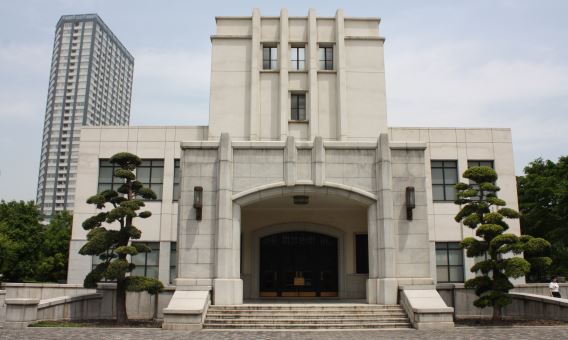 The front façade of the Ichigaya Memorial Hall, the relocated and renovated former front section of Building No. 1 that dates back to the mid-1930s.
The front façade of the Ichigaya Memorial Hall, the relocated and renovated former front section of Building No. 1 that dates back to the mid-1930s.
Tour groups then proceed to the tour high point, Ichigaya Memorial Hall, which as part of Building No. 1 was first completed in 1937 to house the Imperial Japanese Military Academy. Now located at the far corner, to the left of the communications tower, this representative section of Building No. 1 was moved from its original location to make way for Building A, rebuilt, and restored.
Having first exchanged shoes for slippers, tour members are escorted through the main entrance hall of what is in essence a rebuilt time capsule.
The next stop is the dimly lit Grand Hall, where tour groups are shown an informative video entitled The History of Ichigayadai (in Japanese with English subtitles). This very hall served as the court room for the International Military Tribunal for the Far East, otherwise known as the Tokyo Trials, which ran from May 1946 to November 1948. The guides point out the well-disguised patches in the wooden flooring where the original tiles had to be replaced.
 The view looking down from what was the public gallery during the Tokyo Trials. The left-hand side of the Grand Hall is permanently set up for the tour film show, the right-hand side consists of displays of uniforms and other memorabilia.
The view looking down from what was the public gallery during the Tokyo Trials. The left-hand side of the Grand Hall is permanently set up for the tour film show, the right-hand side consists of displays of uniforms and other memorabilia.
Tour groups are shown other rooms upstairs, including the office formerly used in turn by the principal of the Imperial Japanese Military Academy, the Minister of War, and the commanding officer of the JGSDF’s Eastern Army.
Although painstakingly rebuilt, the building lacks its former balcony. It was from here that the author and film actor Yukio Mishima, having arranged to meet the Eastern Army’s commanding officer, delivered an impassioned speech during a coup attempt in November 1970. Met with derision by based troops, Mishima went back inside, where followers participated in his ritual suicide. Three sword cuts in a wooden door attest to the episode.
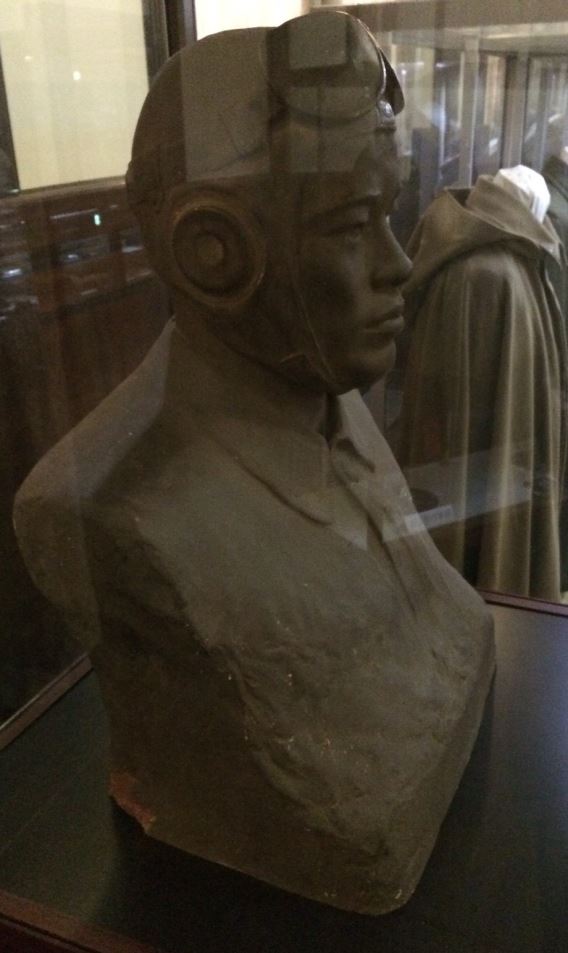
(Above) The sole aviation-related exhibit that J-HangarSpace found in the Grand Hall was this bust of Imperial Japanese Army Air Force fighter pilot Tateo Kato (1903–1942).
(Below) Tateo Kateo stands in front of a Kawasaki Type 95 (Ki-10) fighter at Shijiazhuang, Hebei province, in the spring of 1938. (Photo: via Wikimedia Commons)
Due to the difficulties caused by reflections, this shows only a small section of a large glass photo image taken at a military exercise in Gunma Prefecture in 1934. Among the 3,800 people pictured in the full-size photo, who include the Showa emperor (1901–1989), guides point out two men who went on to become well-known figures: the then Vice-Admiral Isoroku Yamamoto (1884–1943) and the then
newly appointed commander of the 24th Infantry Brigade (and former chief of the
Defense Ministry Personnel Department) Maj. Gen. Hideki Tojo (1884–1948).
After walking past on-site personnel accommodation and taking a break at the Welfare Building, which includes a Starbucks, a convenience store and stores selling SDF souvenirs, the morning tour proceeds to the Outside Helicopter Display. Although overlooked by office buildings, photography is prohibited when passing a sports field en route. Next to JGSDF personnel engaged in physical fitness exercises, revetments bear witness to the occasional presence of mobile Patriot anti-ballistic missile launchers as a precaution against errant North Korean test firings.
 Delivered to the JGSDF in 1977, the displayed UH-1H was withdrawn from active service with the Western Region Helicopter Squadron from Metabaru Army Camp, Saga Prefecture, on February 19, 2002. The aircraft has been a (as you would expect) well-kept permanent fixture at the Ministry of Defense since April 1, 2003.
Delivered to the JGSDF in 1977, the displayed UH-1H was withdrawn from active service with the Western Region Helicopter Squadron from Metabaru Army Camp, Saga Prefecture, on February 19, 2002. The aircraft has been a (as you would expect) well-kept permanent fixture at the Ministry of Defense since April 1, 2003.
Dating back to 1962 and renovated in 1980, the main monument in the Memorial Zone is dedicated to the more than 1,800 SDF personnel who have lost their lives on active duty. As its name suggests, the area was made into a central repository for a dozen or so military monuments and memorials that were previously scattered around other locations. These are mostly positioned discreetly behind the main monument, away from the gaze of passing tour groups.
 The main monument in the Memorial Zone is carved in black and white granite in the shape of Mt. Fuji.
The main monument in the Memorial Zone is carved in black and white granite in the shape of Mt. Fuji.
The occupants of the three other main buildings in the complex, which include the Technical Research and Development Institute (TRDI) in Building D, are mentioned on the way to the top of the escalator that leads back down to the main gate.
Parting Shot
 The Tokyo skyline viewed from the top of the steps leading down to the Ministry of Defense
The Tokyo skyline viewed from the top of the steps leading down to the Ministry of Defense
main gate on Yasukuni-dori.
How To Get There
The Ministry of Defense main gate is a 10-minute walk from Ichigaya Station, which is served by the JR Sobu Line and three Metro lines. The closest station is Akebonobashi on the Toei-Shinjuku Line, which is five minutes’ walk away.
Ichigayadai Tour Information
|
Ichigaya Honmura-cho 5-1, Shinjuku-ku, Tokyo 162-8801 Tel: + 81 (0)3-3268-3111, extension 21904
Offered free every weekday, Monday to Friday
Tour Times Morning: Sign-in 9:10 to 9:20 / Tour 9:30 to 11:45 (Note: As mentioned in the text, there are differences between the morning/afternoon tour content) Remember to take some form of photo identification (passport, resident card or driver’s licence)
J-HangarSpace would like to thank JGSDF Master Sergeant Yukihito Umino and the rest of the Ichigayadai Tour team for a very enjoyable and informative visit.
|
2014 Spring Festival,
U.S. Naval Air Facility Atsugi, Kanagawa Prefecture
May 3, 2014
For many years, the JMSDF traditionally held a combined Maytime children’s event and air show on their side of Atsugi base to coincide with the local Yamato City festival. In more recent times, however, the service has saved money and effort by merely towing some aircraft across to join the static park on the day of their U.S. Navy neighbour’s open house, also held in May. Although not billed as an air show as such, this does feature U.S. military aircraft taking off on afternoon training flights.
The main gate is the sole entry point on Spring Festival Saturday, or Sunday if bad weather has caused a day’s postponement. Prior to the official opening at 10 a.m., the queue to gain entry this year extended along from the main gate, then left all the way down a long road, then left again before turning back on itself in a park! With temperatures in the mid-20s, a survival kit of drinking water, sunglasses, and a hat is highly recommended, if not essential. (See How to Get There section below)
Despite the huge crowd expected, the prime reason of J-HangarSpace’s visit was the opportunity to take some close-ups of a based Kawasaki P-1 patrol aircraft. The effort was rewarded not only by the presence of a P-1 in the static display, but also by another being surprisingly put through its paces on a demonstration flight. While the two prototypes remain engaged on manufacturer testing, all five of the current fleet of five production aircraft are assigned to the JMSDF 51st Fleet Air Squadron’s 511th Flight and could be seen around Atsugi.
With company test pilots Akihiro Sekido and Yoshinao Baba at the controls, the first prototype XP-1 made its maiden flight on September 28, 2007, and the two prototypes were handed over at Atsugi on March 12, 2013. The first prototype is now engaged on a variety of test programmes as the UP-1 at Gifu, and the second prototype has been upgraded to production aircraft standard. The most recent aircraft to join the test programme, the fifth production aircraft (5507) made its maiden flight on December 20, 2013.
This Location Report focuses on providing a photo commentary of the aircraft’s display. A Nose to Tail photo feature has been added to the JMSDF Aircraft Programmes page.

(Above) The third production P-1 slowly wends its way out for takeoff and (below) turns onto
Atsugi’s main runway amid the shimmering heat haze.
The lightly loaded aircraft gathers speed at the start of its takeoff run (above) and gets airborne within a very short distance (below). Its four IHI F7-10 turbofan engines encased in noise-reduction panels,
the P-1 is remarkably quiet for a military aircraft. More importantly, the panels’ primary role is in
inhibiting electronic interference to the aircraft’s sensors.
 In its element on a high-speed flypast, the P-1’s airliner lines belie its role as an anti-submarine warfare (ASW) aircraft. The prototypes have already been used for test flights with underwing-mounted
In its element on a high-speed flypast, the P-1’s airliner lines belie its role as an anti-submarine warfare (ASW) aircraft. The prototypes have already been used for test flights with underwing-mounted
AGM-65F Maverick and ATM-84A-1C Harpoon missiles as well as for decoy flare dispenser tests.
The P-1’s wing has been designed to accommodate eight underwing hardpoints, and depth
charges or unguided torpedoes can be dropped from the aircraft’s ventral weapons bay.

The aircraft from different angles during a more sedate flypast. (Above) The bulge beneath the fuselage hinomaru national marking is part of the aircraft’s sensor suite and that further aft the auxiliary power
unit exhaust. (Below) The 37-slot sonobuoy launcher array under the fuselage aft of the wings is more
clearly visible. The aircraft can also drop 70 sonobuoys via two revolver-type rotary launchers.
 The pilots twice deployed the full-span slats and Fowler flaps to demonstrate the P-1’s impressive low-speed handling characteristics. Manufacturer Kawasaki has trumpeted the P-1 as the first operational
The pilots twice deployed the full-span slats and Fowler flaps to demonstrate the P-1’s impressive low-speed handling characteristics. Manufacturer Kawasaki has trumpeted the P-1 as the first operational
aircraft equipped with a fly-by-light control system that, on an aircraft bristling
with sensors, offers the advantage of reduced electromagnetic interference.
 The aircraft in landing configuration at the end of an impressive demonstration flight at Atsugi.
The aircraft in landing configuration at the end of an impressive demonstration flight at Atsugi.
It is planned that 12 aircraft will eventually be assigned to the base’s 3rd Fleet Air Squadron,
which is due to become the first operational unit in autumn 2015.
Parting Shots
 Their engine intakes covered, the second (5504) and fourth (5506) production P-1s sit parked on the far side of Atsugi air base. All five production P-1s were present on the day of the U.S. Navy event.
Their engine intakes covered, the second (5504) and fourth (5506) production P-1s sit parked on the far side of Atsugi air base. All five production P-1s were present on the day of the U.S. Navy event.
 While the P-1 steals the show, an LC-90 of the Atsugi-based 61st Fleet Air Squadron appears to be
While the P-1 steals the show, an LC-90 of the Atsugi-based 61st Fleet Air Squadron appears to be
sulking inside a hangar.
How To Get There
The closest station to the Atsugi NAF main gate is Sagamino on the Sotetsu Line. On show day, all you need do is follow the crowds on a 15-minute walk.
Sagamino is only two stops from Ebina on the Odakyu Line, around 50 minutes by express from Shinjuku Station in Tokyo. Be aware that Odakyu Line trains stop at the similar-sounding Sagamiono Station.
For the May 2015 event, non-Japanese nationals should look out for Gate 1, tucked away to the right of the main entrance; this fast-track entry point for people with disabilities is open to them, too. Don’t forget to take your passport or Japan resident card for the security procedures.
Nose to Tail: Kawasaki P-1 Patrol Aircraft
 The Kawasaki P-1 patrol aircraft that graced the static display at the U.S. Naval Facility Atsugi Spring Festival in May 2014. This aircraft provided the subject of the following aircraft walkround.
The Kawasaki P-1 patrol aircraft that graced the static display at the U.S. Naval Facility Atsugi Spring Festival in May 2014. This aircraft provided the subject of the following aircraft walkround.
Location Report 6 features in-flight photographs of the third production Kawasaki P-1 patrol aircraft taken at the 2014 Spring Festival at U.S. Naval Air Facility Atsugi, Kanagawa Prefecture. Complementing that report, J-HangarSpace here includes a selection of close-up photos of the fifth and at that time latest production aircraft that was present in the static display area at the same event.
 The nose houses the main Toshiba/TRDI HPS-106 active electronically scanned array (AESA) search radar. The two small excrescences on either side form part of the aircraft’s electronic support measures/radar warning receiver (ESM/RWR) system. This head-on view also shows the
The nose houses the main Toshiba/TRDI HPS-106 active electronically scanned array (AESA) search radar. The two small excrescences on either side form part of the aircraft’s electronic support measures/radar warning receiver (ESM/RWR) system. This head-on view also shows the
four advanced identification friend or foe (AIFF) antennae in front of the windscreen wipers.

The nose gear viewed from the front (above, showing the tow bar attachment point) and from the rear. The wording in the upper part of the photo below indicates the bomb bay hoist access panel.
 Fluttering in the breeze, the two red “remove before flight” flags cover angle of attack (AOA) sensors. The P-1 shares the same cockpit glazing as the C-2, its JASDF transport stablemate. Hidden in a housing under the nose, the Fujitsu HAQ-2 forward-looking infrared radar (FLIR) can be seen
Fluttering in the breeze, the two red “remove before flight” flags cover angle of attack (AOA) sensors. The P-1 shares the same cockpit glazing as the C-2, its JASDF transport stablemate. Hidden in a housing under the nose, the Fujitsu HAQ-2 forward-looking infrared radar (FLIR) can be seen
extended in the last two in-flight photos in Location Report 6.
 Above the forward port-side ESM/RWR device housing (left) is an ice detection sensor, below it the No. 1 pitot tube and total air temperature (TAT) sensor, all of which provide data to the left-hand (captain’s) glass cockpit display. Like the JMSDF’s P-3C Orions, the P-1’s forward dorsal radome is for ESM;
Above the forward port-side ESM/RWR device housing (left) is an ice detection sensor, below it the No. 1 pitot tube and total air temperature (TAT) sensor, all of which provide data to the left-hand (captain’s) glass cockpit display. Like the JMSDF’s P-3C Orions, the P-1’s forward dorsal radome is for ESM;
one further aft is for satellite communications equipment.
 The chocked port main landing gear, which shows off some neat cabling, and wheel well.
The chocked port main landing gear, which shows off some neat cabling, and wheel well.
 The P-1’s ventral sonobuoy launcher system has 37 slots, marked S1-S30, P1-P4, FF, ARL, and FRL.
The P-1’s ventral sonobuoy launcher system has 37 slots, marked S1-S30, P1-P4, FF, ARL, and FRL.
The triangular-shaped grooves closer to the camera are two NACA-type flush intakes to provide
cooling air, presumably for the onboard electronics suite.
 The P-1 is currently the sole application of the 13,000lb-thrust IHI F7-10 turbofan. Although not generally used, thrust reversers are fitted.
The P-1 is currently the sole application of the 13,000lb-thrust IHI F7-10 turbofan. Although not generally used, thrust reversers are fitted.
 The P-1’s inboard engines are particularly close to the ground, which must increase the risk of foreign object ingestion. Each engine has a NACA-type flush air intake positioned on its right front side.
The P-1’s inboard engines are particularly close to the ground, which must increase the risk of foreign object ingestion. Each engine has a NACA-type flush air intake positioned on its right front side.
Written in Japanese only, the sign beneath the square opening on the engine’s cowling warns:
DANGER
Generator oil cooler
High-temperature bleed air exhaust outlet
Keep away when engine running
The Japanese beneath the hook symbols advises “Use only for fan cowl”.
(Above and below) Provision has been made for four of the eight external weapons hardpoints to be located in pairs under the centre section of the wing. The others can be mounted singly in between
and outboard of the engines.
 Prominently positioned beneath the hinomaru national marking on the port side of the rear fuselage is a hot-air exhaust, shown here covered with a red blank, under which is a warning sign advising personnel to keep away when the aircraft’s air-conditioning system is running. The circular object to the right of the hinomaru is a static port. As seen elsewhere on the aircraft, the rear fuselage sports several colour-coded blade antennae; this array is for the sonobuoy communications and reference systems. The English version of the battery location advisory (left) takes up a lot of space aft of the wing root.
Prominently positioned beneath the hinomaru national marking on the port side of the rear fuselage is a hot-air exhaust, shown here covered with a red blank, under which is a warning sign advising personnel to keep away when the aircraft’s air-conditioning system is running. The circular object to the right of the hinomaru is a static port. As seen elsewhere on the aircraft, the rear fuselage sports several colour-coded blade antennae; this array is for the sonobuoy communications and reference systems. The English version of the battery location advisory (left) takes up a lot of space aft of the wing root.
 The starboard side of the rear fuselage duplicates the port side’s red-blanked hot-air exhaust and static port (below and to the left of the hinomaru, respectively). Added on this side is a large auxiliary power unit (APU) exhaust (left) and rectangular APU fire access panel. A small, circular lavatory vent has
The starboard side of the rear fuselage duplicates the port side’s red-blanked hot-air exhaust and static port (below and to the left of the hinomaru, respectively). Added on this side is a large auxiliary power unit (APU) exhaust (left) and rectangular APU fire access panel. A small, circular lavatory vent has
somehow ended up positioned within the hinomaru.
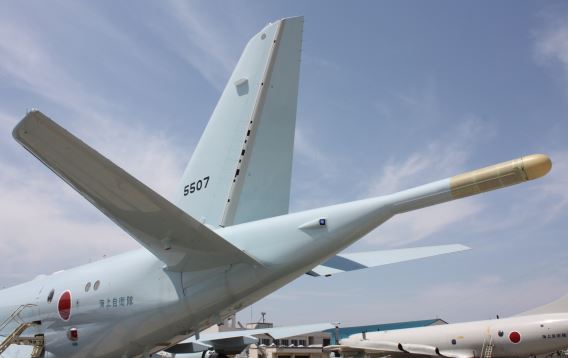 The P-1’s tail boom houses the Mitsubishi Electric HSQ-102 magnetic anomaly detection (MAD) system. Two missile approach warning (MAW) system devices are positioned on either side of the tail, aft of the horizontal stabilizer that is identical to that fitted to the C-2. The underside of the rear fuselage also sports four more IFF antennae.
The P-1’s tail boom houses the Mitsubishi Electric HSQ-102 magnetic anomaly detection (MAD) system. Two missile approach warning (MAW) system devices are positioned on either side of the tail, aft of the horizontal stabilizer that is identical to that fitted to the C-2. The underside of the rear fuselage also sports four more IFF antennae.
Location Report 5
Sakura Matsuri (Cherry Blossom Festival),
JASDF Kumagaya Air Base, Saitama Prefecture
April 6, 2014
 Taken from the Kumagaya AB website, the poster advertising this year’s Sakura Matsuri gives a good idea of the crowds the event normally attracts.
Taken from the Kumagaya AB website, the poster advertising this year’s Sakura Matsuri gives a good idea of the crowds the event normally attracts.
The event now known as the Sakura Matsuri (Cherry Blossom Festival) at Kumagaya AB has been a permanent fixture in the local spring calendar since the 1960s. Boasting around 900 cherry trees, the base provides the Japanese with an ideal location to pursue their favourite if fleeting pastime of eating and drinking in groups beneath the pink blossom.
Lacking a runway and any based operational aircraft, the static display is limited to a visiting JASDF helicopter or two. For the most part, the afternoon flying display consists of a helicopter demonstration flight and appearances by aircraft from nearby Iruma AB. This year, flying displays by a Hyakuri-based UH-60J and a Fuji T-7 from Shizuhama had to be cancelled due to the weather, but a pair of Kawasaki T-4s from Iruma made three passes. Making for conditions that were suitable only for the most die-hard of visiting picnickers, strong winds served to keep attendance down to around 18,000 visitors for the day.
Another opportunity to visit the base is provided by the traditional O-Bon festival at the end of August.
 (Above) On sole static display during the morning, the Iruma-based CH-47J Chinook pilot wowed the crowd during the helicopter’s afternoon demonstration flight. (Below) A crew member waves sayonara after the pilot caused a mini cherry blossom storm during a brief landing.
(Above) On sole static display during the morning, the Iruma-based CH-47J Chinook pilot wowed the crowd during the helicopter’s afternoon demonstration flight. (Below) A crew member waves sayonara after the pilot caused a mini cherry blossom storm during a brief landing.

Kumagaya Base Archives
Taking the first turn to the right on the way down from the main gate brings you to the Kyoiku Sankokan (literally Education Reference Centre). From the entrance lobby, a corridor naturally leads you first into a room covering Kumagaya’s early days.
From the mid-1930s until early 1945, the airfield was a hive of activity as an Imperial Japanese Army Air Force (IJAAF) flying school. Officially opened at a ceremony held December 14, 1935, the first intake of students commenced classes in the spring of 1936.
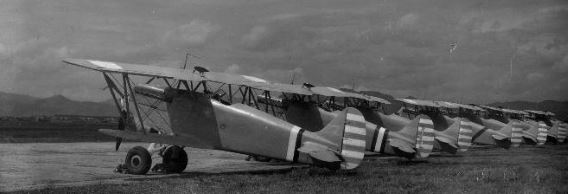 IJAAF Kawasaki Type 95 (Ki-10) fighters were painted to represent Chinese Nationalist Air Force Polikarpov I-15 fighters for the filming of Moyuru Oozora (Burning Sky), which was filmed at
IJAAF Kawasaki Type 95 (Ki-10) fighters were painted to represent Chinese Nationalist Air Force Polikarpov I-15 fighters for the filming of Moyuru Oozora (Burning Sky), which was filmed at
Kumagaya and released in 1940. (Photo: via Wikimedia Commons)
Kumagaya progressively took over the elementary pilot training functions formerly undertaken at Tokorozawa, also in Saitama, when space considerations at the latter dictated that the focus be placed on technical and maintenance training. By the late 1930s, Kumagaya was reportedly home to 200 instructors and a total of around 600 students. With the expansion of pilot training to meet combat demand, more than 20 satellite schools at one stage or another came under Kumagaya’s command. All training operations ceased at Kumagaya in February 1945, when the base was assigned to the 1st Air Army’s 52nd Air Division.
Naturally, the rooms are divided into two periods that reflect the airfield’s prewar and wartime IJAAF existence and the period from the mid-1950s to the present day.
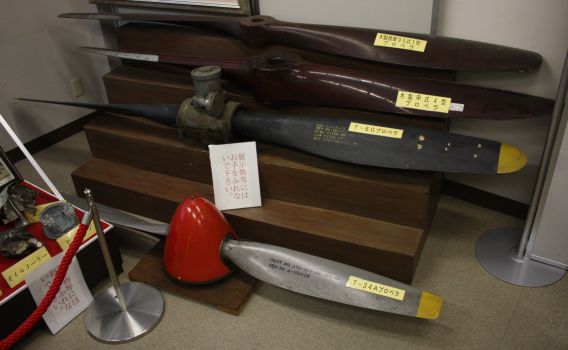 (From top): Wooden propellers from an IJNAF Tachikawa Type 95-1 (Spruce) biplane trainer and an Otsu 4 Kata (Nieuport 29C) fighter; metal propellers from a North American T-6G Texan and
(From top): Wooden propellers from an IJNAF Tachikawa Type 95-1 (Spruce) biplane trainer and an Otsu 4 Kata (Nieuport 29C) fighter; metal propellers from a North American T-6G Texan and
Beech T-34A Mentor.
Displayed in the corner of the first room to the left of the entrance is a stack of four propellers (see photo above). Next to those is a showcase containing relics—including a generator and parts of a fuel tank, oil cooler, piston, and wing—from a crashed Kawasaki Type 5 (Ki-100) fighter. A frame of photos placed in the same showcase was not well placed for reading, but a large framed display directly above reveals more of the details.
The main photo here shows 18th Flying Regiment pilot Master Sgt. Yasuo Heima, whose period of military training had started when he was accepted to be member of the Tokyo Army Air Cadet School’s ninth intake in October 1939 and ended upon his graduation from Kumagaya. Having seen action on the island of Timor in Southeast Asia in 1943, Heima was brought back to help defend Japan and was among those who took off from the 18th’s base at Matsudo in Chiba Prefecture to attack a formation of B-29s on April 7, 1945. Newspaper cuttings (dated February 24, 1972) report the discovery (after 27 years) of the aircraft Heima had been flying that day at a site near Koshigaya in Saitama; his had been the first combat loss of a Type 5.
 The display in memory of Master Sgt. Yasuo Heima, killed in action on April 7, 1945. The newspaper cuttings detail the discovery of the Type 5 fighter he was flying that day. The lower left
The display in memory of Master Sgt. Yasuo Heima, killed in action on April 7, 1945. The newspaper cuttings detail the discovery of the Type 5 fighter he was flying that day. The lower left
handwritten text gives details of the Type 5, while the text on the right describes
the war situation at that time and Heima’s flying career.
Moving to the left from the poignant memorial to Master Sgt. Heima, the visitor is presented with further photographs. Two supplied by the wartime fighter pilot Susumu Koyama give some idea of what Kumagaya was like in its training school heyday.
Born on Okayama Prefecture in 1923, Koyama had entered the Tokyo Army Air Cadet School in April 1940 before starting a course at Kumagaya in April 1941.
First published in 1996 and reprinted in 2010, Koyama’s memoirs unfortunately only mention Kumagaya in passing in the first paragraph, in which he refers to leaving the school, encouraged by the pilot’s wings on his chest, on December 1, 1942, when Japan was in the thick of the Pacific War. He paints a picture of the newly qualified pilots walking in two and threes the kilometer or so to the train station to head off on their separate ways to their assigned units.
(Koyama’s first assignment was on the Nakajima Type 97 [Nate] with the 246th Flying Regiment based at Kakogawa near Osaka, but he was transferred to the Kawasaki Type 3 [Tony]-equipped 68th Fighter Unit in New Guinea in September 1943. Having managed to survive the war, Koyama eventually worked as a civilian pilot.)

(Above and below) These photos give some idea of Kumagaya’s former existence as an IJAAF flight training school. They were donated by former student and wartime fighter pilot Susumu Koyama, then a resident of Matsuyama in Ehime Prefecture. In September 1943, Koyama was assigned to the Kawasaki Ki-61 (Tony)-equipped 68th Flying Regiment from Wewak airfield in New Guinea and later wrote a book about his experiences.
Other Snapshots of Kumagaya Life in 1940s
Although not part of the archives, somewhat more of a student pilot’s perspective of life at Kumagaya can be gleaned from the memoirs of another IJAAF fighter pilot, Izumi Miura.
Born in what is now Kikugawa, Shizuoka Prefecture, in 1925, Miura entered the Tokyo Army Air Cadet School at age 15 in March 1940 and graduated from Kumagaya in November 1942, in both cases a month before Koyama.
The second chapter of Miura’s memoirs is devoted to his time at Kumagaya. At that time, the base was also the cradle of IJAAF bomber units, and he recalls the excitement of seeing formations of Mitsubishi Type 97 (Sally) bombers overhead as he stepped off the train at Kagohara station and the takeoffs and landings of the based Tachikawa Type 95 (Spruce) training aircraft.
 The unit marking of a red design on a white disc sported on the rudder of this Tachikawa Ki-9 (Spruce) trainer identifies the aircraft as one of the many examples of the type that were assigned to the Kumagaya Army Flying School. (Photo: via Wikimedia Commons)
The unit marking of a red design on a white disc sported on the rudder of this Tachikawa Ki-9 (Spruce) trainer identifies the aircraft as one of the many examples of the type that were assigned to the Kumagaya Army Flying School. (Photo: via Wikimedia Commons)
Miura was one of 120 students who made up the 1st Company of Kumagaya’s tenth-term intake. For the first year, students were given tuition on the technical aspects required by tyro pilots, including aircraft engineering and—as it turns out, providing a link with the base’s current activities—meteorology and communications.
The book provides invaluable snapshots of student life at that time. Divided into groups of 12, the students would change into overalls every day for the practical part of the aircraft engineering course, which over five months involved stripping down and re-assembling an assigned Type 95; for the third repeat of the exercise, the time was reduced to 15 days. Miura relates the added pleasure the pilots derived from flying aircraft that they had helped to put together.
(Izumi Miura’s active career followed that of Susumu Koyama in that his first assignment was also to a Nate unit, the 4th Flying Regiment at Ozuki, Yamaguchi Prefecture, after which he transitioned to the Tony-equipped 78th in Harbin, China (at that time Japanese-held Manchukuo). After retiring from a long postwar career in the police force, Izumi Miura worked for a private company. He passed away aged 64 in October 1989.)
 Seen in this displayed photo are five former Kumagaya Army base commanders: (Clockwise from top left): The third commander, Lt. Gen. Eijiro Ebashi; the second, Major Gen. Kenjiro Nagasawa;
Seen in this displayed photo are five former Kumagaya Army base commanders: (Clockwise from top left): The third commander, Lt. Gen. Eijiro Ebashi; the second, Major Gen. Kenjiro Nagasawa;
the first, Major Gen. Tetsuji Giga; the fifth, Major Gen. Yoshio Hongo; and the
seventh commander, Major Gen. Katsuji Hirata.
Back at the archives, the next photo frame (shown above) contains portraits of five former Kumagaya base commanders. Seemingly unrelated to the surrounding photos, the handwritten note in the middle of a frame states that Japan’s first involvement in air combat took place [during World War I] at 6:00 a.m. on October 13, 1914, at the time of the fall of [German-held] Tsingtao [in China]. At that time a lieutenant, Nagasawa (written using different kanji to that under the photo of the second base commander), who was flying a Nieuport, came upon and attacked a Rumpler aircraft flown by German Navy Lt. [Gunther] Plüschow. (J-HangarSpace has sought clarification.)
The display case beneath these photos contains a wide range of course textbooks. These include aircraft handling manuals and books containing diagrams to accompany engineering courses on, for example, aircraft, instrumentation, and the Bristol Jupiter VI radial engine that Nakajima built under licence from 1925 as the Ha-1 Kotobuki (Longevity).
Mounted on the wall around the corner are a series of large paintings depicting IJAAF aircraft. Confining coverage to aviation-related content, subsequent displays contain models of early base buildings alongside examples of pilot clothing and equipment. The display case on the far wall contains radios and other communications equipment. Of pre-Kumagaya interest here are some photos taken at the time of the 1919 French Aviation Mission to Japan.
 A 1/48 scale model of a Tachikawa Type 95 Trainer (Spruce). The Kumagaya Army Flying School tail marking comprised a straight line, from the kanji for “one”, within a white-edged circle.
A 1/48 scale model of a Tachikawa Type 95 Trainer (Spruce). The Kumagaya Army Flying School tail marking comprised a straight line, from the kanji for “one”, within a white-edged circle.
 A photo shows the 12 pilots assigned to the 80th Shinbutai—the name contains the meaning of “unit that will demonstrate the power wielded by the armed”—a special attack force formed from the Kumagaya-based 52nd Air Division in 1945. The photo is accompanied by a list giving the pilots’ names and
A photo shows the 12 pilots assigned to the 80th Shinbutai—the name contains the meaning of “unit that will demonstrate the power wielded by the armed”—a special attack force formed from the Kumagaya-based 52nd Air Division in 1945. The photo is accompanied by a list giving the pilots’ names and
ranks as well as by inscriptions written by the pilots themselves. Eleven of those in the picture
were killed in action when flying solo in Tachikawa Ki-55 (Ida) trainers against U.S. Navy
ships off Okinawa on April 22, 1945; the other pilot met the same fate on April 27.
More Poignant Reminders
Kumagaya very quickly became U.S. Army Camp Whittington in September 1945, the month after the end of the war, and remained so until handed back to Japanese ownership in July 1958. Officially given JASDF air base status in August 1958, Kumagaya welcomed the 2nd Air Training Squadron that had provisionally formed at Utsunomiya Army Camp in Tochigi Prefecture in March that year. The next major development came in October 1959, when a branch school of the 2nd Technical School (TS) was formed complete with a Non-Commissioned Officer Cadet School (NCOCS). In July 1961, the 2nd TS branch was given full status as the 4th TS, which was placed in command of the NCOCS. The names of graduates from the 53 intakes into the cadet school and a chronology covering the years from 1954 to 2011 are combined with plaques, uniforms, and insights into student life in a separate room.
Today, the area covered by the base (42 acres, 170,000 sq. metres) is about a fifth of what it was in its flying school heyday. The training courses run by the 4th TS focus on the operation and maintenance of IT-based equipment used in communications and weather prediction.
Equipped with a video screen at either end, the long room on the other side of the corridor from the entrance lobby is mainly geared toward PR and recruitment. Its displays therefore feature general exhibits on the JASDF. Flight instruments from a KV-107II are on display in one show case.
There was one small, quiet room in the Education Reference Centre where it seemed inappropriate to take photographs. With a memorial at one end directly opposite the door, the pure white walls on both sides bore photos of Kumagaya 4th Technical School graduates who had tragically lost their lives in SDF service. Giving their full names in Japanese and English, the four lost as a result of flying accidents were:
First photo on the right-hand wall: 野澤俊雄 (Toshio Nozawa), 29th Term Intake
Born in Saitama Prefecture, Nozawa joined the 4th TS on March 31, 1983. He was killed in a Fuji T-1 jet trainer accident on April 17, 1990, while serving at Ashiya AB in Fukuoka Prefecture.
Second on right: 菊井良祐 (Ryosuke Kikui), 25th Intake
Originally from Nara Prefecture, Kikui attended the 4th TS from April 3, 1979, but transferred to the JMSDF’s 221st Air Training Squadron on March 29, 1982. He was the copilot on board a JMSDF HSS-2B Sea King helicopter that crashed into the sea off Shizuoka Prefecture on March 27, 1986.
Third on right: 酒元光行 (Mitsuyuki Sakamoto), 22nd Intake
Kagoshima Prefecture native Sakamoto started with the 4th TS in April 1976. He was a crew member on board the C-1 that crashed into the sea off Tottori Prefecture on June 28, 2000.
First on the left-hand wall: 伊藤猛 (Takeshi Ito), 15th Intake
Born in Mie Prefecture, Ito joined the 4th TS on March 24, 1969. He was killed on April 11, 1977, when the F-86F Sabre he was piloting on a training flight from Misawa AB crashed into the sea off Aomori Prefecture.
Outdoor Monuments and Memorials 1

(Above and below) Mounted on plinths in front of the Kyoiku Sankokan (Education Reference Centre) is the latest addition to the Kumagaya AB collection. Delivered in 1986, Mitsubishi F-1 arrived at Kumagaya following its retirement from service with 8 Sqn in 2005.


(Above and below) Formed from the tail of a Mitsubishi F-1 fighter, this monument was put in place to
mark the 50th anniversary of the forming of the JASDF Non-Commissioned Officer Cadet School
(NCOCS). Aimed at junior high school graduates aged 16 to 20, this school offered standard high
school courses alongside technical training and tuition on communications and electronics.
The inscription on the black plaque (負けじ魂) means ‘unyielding spirit’.
Having accepted the first course in 1958, the curtain came down on March 19, 2011, when the
53rd and final intake graduated.

The following photos are arranged in the order the aircraft appear among the cherry trees on the left of the road leading down from the main gate. As you would expect, it can get quite crowded around these aircraft earlier in the day, so the best time to photograph them is when the show is coming to an end around 3 p.m. (This is generally the case with all static displays at air shows in Japan.) At Kumagaya the disadvantage then is that the best of the afternoon light is illuminating the sides of the aircraft with the over-wing steps.
North American F-86D-31 Sabre
 This F-86D ended up at Kumagaya after a decade of service with the JASDF,
This F-86D ended up at Kumagaya after a decade of service with the JASDF,
from August 1958 to February 1968.
Lockheed T-33A
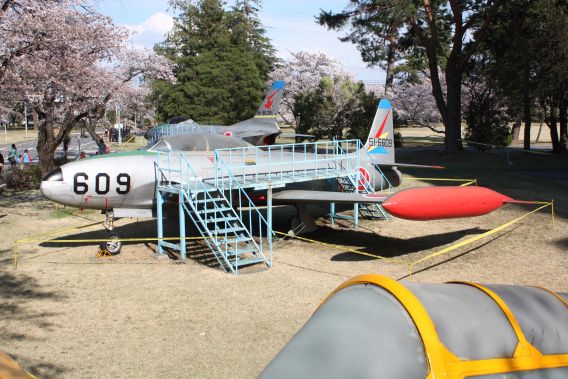 The JASDF service career of Kumagaya’s T-33A lasted from January 1955 to October 1964. Although they make good vantage points from which to photograph, the steps up to the aircraft cockpits have more than one down side.
The JASDF service career of Kumagaya’s T-33A lasted from January 1955 to October 1964. Although they make good vantage points from which to photograph, the steps up to the aircraft cockpits have more than one down side.
North American T-6G*
 A Kumagaya collection resident since May 1965, this T-6G was handed over to the JASDF in
A Kumagaya collection resident since May 1965, this T-6G was handed over to the JASDF in
December 1955. It still bears the white, arrow-like tail marking of its time with the
2nd Flight of the 14th Flying Training Wing’s Maintenance Group.
North American F-86F-40 Sabre
 Delivered in October 1958, this F-86F was struck off charge in April 1962. Although the aircraft originally retained its 1st Air Wing markings, these were changed to those of the Iruma-based
Delivered in October 1958, this F-86F was struck off charge in April 1962. Although the aircraft originally retained its 1st Air Wing markings, these were changed to those of the Iruma-based
Air Defence Command Headquarters Support Flight. Note also that a black protective
coating has been applied to the cockpit canopy.
Lockheed F-104J Starfighter*

Delivered in October 1967, this aircraft was withdrawn from 207th Sqn service early in 1984 and acquired the “F-104 Brothers” marking on its engine intake (below) at
that year’s inter-squadron TAC Meet.
* (Postscript) For Kumagaya’s F-104J and T-6G, the end had come by early February 2021, when the winning-bid contractor was paid precisely 1,358,023 yen to break up and remove them.
Outdoor Monuments and Memorials 2
 Shown top left and bottom right in this selection of vintage photos on display is the monument erected to commemorate the visit made by the Showa emperor in 1938. The monument bears the name Miizugahara, the name of a place that is now part of the city of Kumagaya. As you would expect, the memorial remains in place to this day. The other photos show Kumagaya Flying School as it looked when opened in 1935.
Shown top left and bottom right in this selection of vintage photos on display is the monument erected to commemorate the visit made by the Showa emperor in 1938. The monument bears the name Miizugahara, the name of a place that is now part of the city of Kumagaya. As you would expect, the memorial remains in place to this day. The other photos show Kumagaya Flying School as it looked when opened in 1935.
 Dedicated to the arawashi (“wild eagles”), the moniker given to Japanese pilots in general during the Pacific War, this memorial is located further down from and on the same side of the road as the base collection aircraft. Thousands of young eagles left the nest that was Kumagaya during its time as a training establishment, so survivors built the monument in May 1975 to comfort the spirits of
Dedicated to the arawashi (“wild eagles”), the moniker given to Japanese pilots in general during the Pacific War, this memorial is located further down from and on the same side of the road as the base collection aircraft. Thousands of young eagles left the nest that was Kumagaya during its time as a training establishment, so survivors built the monument in May 1975 to comfort the spirits of
the pilots lost in battle and to convey their story to the generations that followed.
The monument is inscribed with words written by IJAAF officer Michio Sugawara (1888–1983),
who attained the rank of lieutenant general. Dated March 1999, the stone lanterns on
either side were added by the monument’s preservation association.
Base Map
 The main gate is along from the national flag seen on the left of this on-base map.
The main gate is along from the national flag seen on the left of this on-base map.
Getting There
The closest railway station to Kumagaya AB is Kagohara on the Japan Railway (JR) Takasaki Line, which can be reached in about an hour from Ueno Station in Tokyo. From the south exit of the station it’s only a 20-minute walk along pleasantly wide streets laid out in a grid pattern to the main gate.
In the run up to the festival, the base website provides a more detailed map (shown in the poster at the start of this report) than what normally appears at:
http://www.mod.go.jp/asdf/kumagaya/page/kumagaya.htm
Parting Shot
 “The party’s over, it’s time to call it a day”, and life returns to normal at Kumagaya AB. As is the case with many public events in Japan, the end of an air show is marked by the playing of the instrumental version of a well-known folk song over the public address. Dating back to 1877, Hotaru no Hikari
“The party’s over, it’s time to call it a day”, and life returns to normal at Kumagaya AB. As is the case with many public events in Japan, the end of an air show is marked by the playing of the instrumental version of a well-known folk song over the public address. Dating back to 1877, Hotaru no Hikari
(The Glow of the Firefly) was written to the tune of the traditional Scottish song Auld Lang Syne.
Want to Find Out More? On IJAAF Flying Schools?
On the 1919 French Aviation Mission to Japan, mentioned in passing in this report?
Japanese-Language Reference Sources Koyama, Susumu, Aa, Hien Sentotai (Ah, Hien Combat Unit), Kojinsha NF Library, Tokyo, 2010
|
Aircraft Division, ShinMaywa Industries, Ltd.
Konan Plant, Kobe, Hyogo Prefecture
February 19-20, 2014
 Cascades of water gushing from its nosewheel well, JMSDF ShinMaywa US-1A rescue amphibian 9089 gets airborne from the sea off Kobe. The interesting, curtain-like “shock wave” effect is caused by the aircraft’s boundary layer control (BLC) system.
Cascades of water gushing from its nosewheel well, JMSDF ShinMaywa US-1A rescue amphibian 9089 gets airborne from the sea off Kobe. The interesting, curtain-like “shock wave” effect is caused by the aircraft’s boundary layer control (BLC) system.
For the second time in six months, J-HangarSpace was in the fortunate position to be invited to ShinMaywa’s Konan Plant. On this occasion, people’s attention and camera lenses were focused on a rare spectacle: the final manufacturer test flights scheduled for one of the JMSDF’s two remaining US-1A rescue amphibians.
Kobe Revisited
As described in Location Report 1, J-HangarSpace’s August 2013 visit to ShinMaywa’s Konan Plant was very informative on the one hand but something of a disappointment on the other. Informative in that the large group from the Japan Aviation Journalists’ Association (JAJA) was granted privileged access to the main attraction, the second prototype US-2 rescue amphibian; disappointing in that the aircraft remained immobile due to flight instrumentation problems.
Once again kindly organized through the JAJA, this second visit was worked around the test flights that follow the culmination of an aircraft’s periodic maintenance check (progressive aircraft rework, or PAR, in JMSDF parlance). In this case, the check procedures had been carried out on the penultimate US-1A (9089), one of only two that remain in service.
9089’s Days Are Numbered
The event was billed as the last time this particular aircraft would be returning to its birthplace in Kobe. Having been accepted for service by the JMSDF on December 15, 2001, 9089 is planned to be retired later this year. Then the only aircraft of the type remaining in service will be 9090, the last of the 20 US-1/US-1As built and an aircraft that amazingly marked only the ninth anniversary of its handover on February 22.
Six months or so after 9090’s final PAR overhaul next year, personnel from the 71st Fleet Air Squadron at Iwakuni, Yamaguchi Prefecture, will follow tradition by decorating the aircraft’s bow with a hand-made garland and conduct a farewell ceremony. The US-1A will then disappear from Japan’s skies.
Seize the Day(s)
As the testing was geared to returning the aircraft in question to service as soon as possible, the aircraft’s interior was declared out of bounds on this occasion. More than compensating for the denied access, over two days two somewhat smaller JAJA groups were given the opportunity denied them back in September, namely to witness and photograph the aircraft taking off from and landing back on the sea off Kobe. J-HangarSpace was in the fortunate position to be able to book very reasonably priced direct flights with Skymark Airlines from Tokyo’s Haneda Airport and to stay for the both days, just in case.
The JAJA groups were once again met at the Konan Plant’s main gate by ShinMaywa test pilot Yoshimasa Miyamoto. On the first morning, the visitors arrived just in time to witness the aircraft undergoing engine runs in a pen screened on two sides close to the Konan Plant’s slipway. Having become accustomed to seeing slightly worn-looking US-1As in unit service—despite rigorous cleaning operations, the saltwater environment, the aircraft’s main engine exhausts as well as the boundary layer control (BLC) airflow outlets take their toll on the paintwork—it made a change to observe a shiny, in effect factory-fresh example. After stopping briefly at the test flight crew’s office overlooking the apron and donning the mandatory hard hats, the group was escorted down to watch the aircraft being towed around to face the slipway.
Swell Party
Then it was all aboard a boat to head out to sea, accompanied by another vessel, to be in position well ahead of the aircraft’s planned departure time. It being February, weather conditions could best be described as bracing, but both days were fortunately sunny and clear.
The boat carrying the JAJA group was equipped with several smoke flares, which when deployed on the surface of the water can burn for 15 minutes to mark the sea lane and show the flight crew the wind direction.
It was some time before the small dayglo dots that were 9089 could be picked out against Kobe’s industrial shoreline. Naturally in constant radio contact, the ship’s captain manoeuvred his vessel to be alongside the sea lane selected for takeoff.
Also present was local aviation photographer Takahiro Nakano, who provided J-HangarSpace with some invaluable tips on how to photograph from a pitching and rolling boat out at sea.
In command of the aircraft on both days was another company pilot, Shotaro Mori, whose JMSDF squadron career was spent entirely on ShinMaywa types. Having passed a test pilot course to be involved in the US-1A’s development with the 51st Fleet Air Squadron at Atsugi, Kanagawa Prefecture, Mori served with the 71st at Iwakuni for around four years before leaving the JMSDF to take up his current position. Messrs. Miyamoto and Mori were the two pilots at the controls for the maiden flight of the then US-1AKai (the prototype US-2) in December 2003.
The coverage for the remainder of this location report takes the form of a photo commentary, using images from both days divided into six phases of the flight.
(1) Prior to Engine Start
 The imposing star of the show is towed by a tug toward the slipway. The 19th US-1/US-1A to enter service with the JMSDF, 9089 was taken on charge in December 2001. For comparison,
The imposing star of the show is towed by a tug toward the slipway. The 19th US-1/US-1A to enter service with the JMSDF, 9089 was taken on charge in December 2001. For comparison,
the first US-1, 9071, was handed over in March 1975, converted to US-1A
standard in 1981, and struck off charge as long ago as January 1986.
 The aircraft at rest just short of the slipway, photographed from the boat carrying the JAJA group. Before moving onto the slipway, the outboard engines are put into reverse thrust to control forward motion. Moored to the right of the slipway is the speedboat that serves the same function as the
The aircraft at rest just short of the slipway, photographed from the boat carrying the JAJA group. Before moving onto the slipway, the outboard engines are put into reverse thrust to control forward motion. Moored to the right of the slipway is the speedboat that serves the same function as the
“follow me” car at airports.
(2) Taxying Out
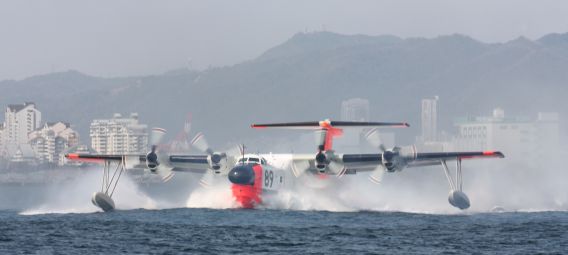 As there is a need to check the engines’ power and responsiveness out on the water, where brakes are inoperative, the flight crew does this when snaking their way out toward the takeoff point.
As there is a need to check the engines’ power and responsiveness out on the water, where brakes are inoperative, the flight crew does this when snaking their way out toward the takeoff point.
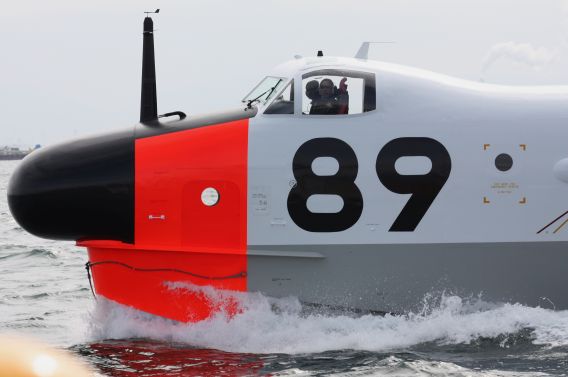 ShinMaywa test pilot Shotaro Mori glances across at the boat carrying the ShinMaywa takeoff preparation team and the visiting journalists’ group. (The plume of smoke that seems to be
ShinMaywa test pilot Shotaro Mori glances across at the boat carrying the ShinMaywa takeoff preparation team and the visiting journalists’ group. (The plume of smoke that seems to be
coming from the rear of the cockpit is from a factory chimney on the shore!)
 This view shows the open intake doors on top of the main wing. The circular intake with its flap open on the port side and the rectangular flap opening on the starboard side provide air for the BLC engine and the auxiliary power unit (APU), respectively.
This view shows the open intake doors on top of the main wing. The circular intake with its flap open on the port side and the rectangular flap opening on the starboard side provide air for the BLC engine and the auxiliary power unit (APU), respectively.
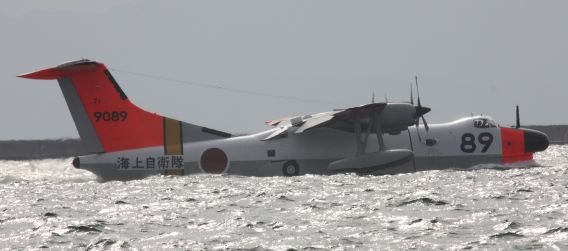 Making a striking image against the sun-dappled sea, the aircraft is slowly taxied to the takeoff point. Depending on the wind direction, one or other wing float will be in contact with the surface of
Making a striking image against the sun-dappled sea, the aircraft is slowly taxied to the takeoff point. Depending on the wind direction, one or other wing float will be in contact with the surface of
the water when taxiing in this configuration.
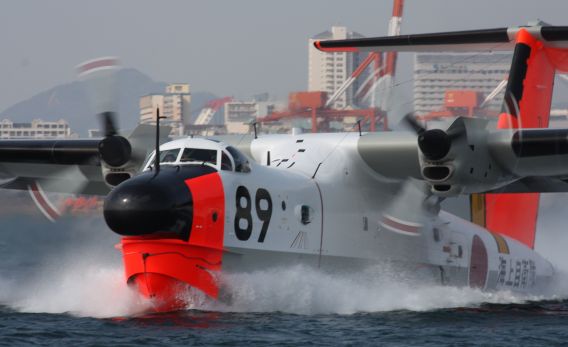 The mast atop the hull nose houses the oscillators for the angle of attack and turn-and-slip indicators. Jutting out from the mast is the crossbar known as the kanzashi (ornamental hairpin), which comes
The mast atop the hull nose houses the oscillators for the angle of attack and turn-and-slip indicators. Jutting out from the mast is the crossbar known as the kanzashi (ornamental hairpin), which comes
into its own for landing. When aligned with the horizon at 500 feet, this simple device makes the
required angle of 6.5 degrees. Just visible to the left and right of the mast are the pitot tubes.
(3) Takeoff
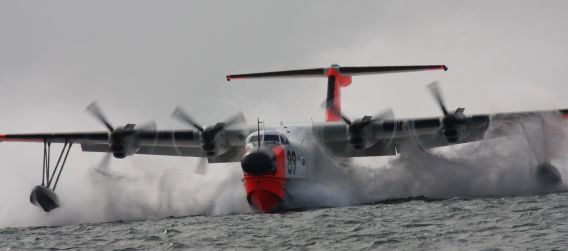 Like any flying boat, the US-1A amphibian makes an impressive sight in its element out on the water. Thanks to its BLC system, the aircraft is capable of taking off at a mere 50 knots.
Like any flying boat, the US-1A amphibian makes an impressive sight in its element out on the water. Thanks to its BLC system, the aircraft is capable of taking off at a mere 50 knots.

(Above and below) On climb out, the aircraft’s flaps are set to 40 degrees at 70 knots and to 20 degrees at 100 knots, when the BLC setting is moved to idle. The flaps are fully raised and the BLC finally switched off when 130 knots has been attained.
(4) Landing
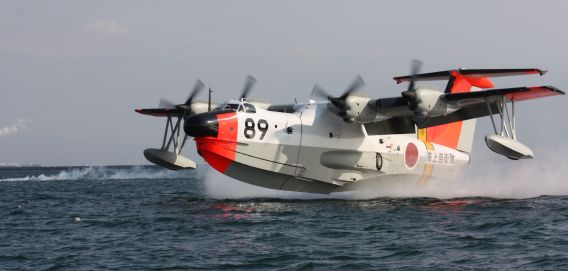 On the point of touchdown, the smoke flare is visible on the surface of the water to the left. Immediately prior to touchdown the aircraft is configured with 60 degrees of flap, height 50 feet, speed around 50 knots and a nose-up attitude of 6.5 degrees. Unlike normal aircraft, the US-1A seems to
On the point of touchdown, the smoke flare is visible on the surface of the water to the left. Immediately prior to touchdown the aircraft is configured with 60 degrees of flap, height 50 feet, speed around 50 knots and a nose-up attitude of 6.5 degrees. Unlike normal aircraft, the US-1A seems to
land gently in slow motion.
 No use is made of propeller reverse thrust immediately after landing. Experiments were conducted into the possibility in the case of the US-1A’s predecessor, the PS-1 patrol aircraft. Although this technique did have the effect of shortening the distance across the water, there was a fear that the spray
No use is made of propeller reverse thrust immediately after landing. Experiments were conducted into the possibility in the case of the US-1A’s predecessor, the PS-1 patrol aircraft. Although this technique did have the effect of shortening the distance across the water, there was a fear that the spray
produced by the technique would damage the engines or propellers. As a result,
the technique was never used operationally.
 After touchdown the flaps are raised and the BLC engine is set to idle. When the hull bites into the water, the aircraft very quickly turns into a boat.
After touchdown the flaps are raised and the BLC engine is set to idle. When the hull bites into the water, the aircraft very quickly turns into a boat.
(5) The Long Taxi Ride Home
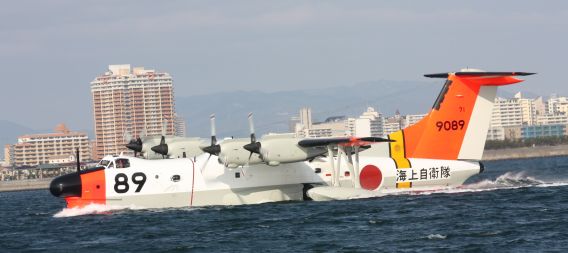 Beautifully lit by the afternoon sun, 9089 is slowly taxied back to the Konan Plant.
Beautifully lit by the afternoon sun, 9089 is slowly taxied back to the Konan Plant.
The aircraft had returned from a visit to Iwakuni, where shimmy tests were
carried out as part of the post-PAR procedures.
 The flight crew lowers the undercarriage prior to approaching the slipway. The undercarriage’s mechanism is of a very complex design to retract the wheels into a narrow bay yet for them to
The flight crew lowers the undercarriage prior to approaching the slipway. The undercarriage’s mechanism is of a very complex design to retract the wheels into a narrow bay yet for them to
be set sufficiently wide apart when extended.
(6) Back on Terra Firma
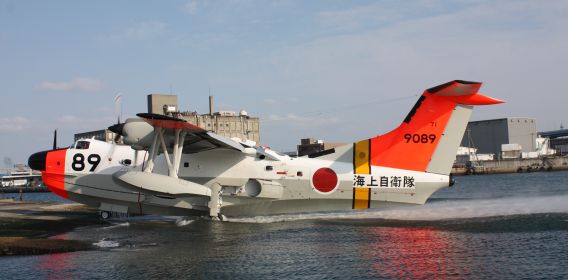 Its undercarriage making waves and the propwash rippling the water’s surface, 9089 mounts the Konan Plant’s slipway. This rare sight can usually be witnessed at the annual air show at JMSDF Omura
Its undercarriage making waves and the propwash rippling the water’s surface, 9089 mounts the Konan Plant’s slipway. This rare sight can usually be witnessed at the annual air show at JMSDF Omura
in Nagasaki Prefecture. The arrival of a ShinMaywa aircraft that then uses the slipway, which
dates back to Imperial Japanese Navy times, traditionally forms one of the show’s highlights.
 A ShinMaywa ground crew member gives the thumbs up sign as the pilot slowly edges the aircraft forward onto the apron at the Konan Plant.
A ShinMaywa ground crew member gives the thumbs up sign as the pilot slowly edges the aircraft forward onto the apron at the Konan Plant.
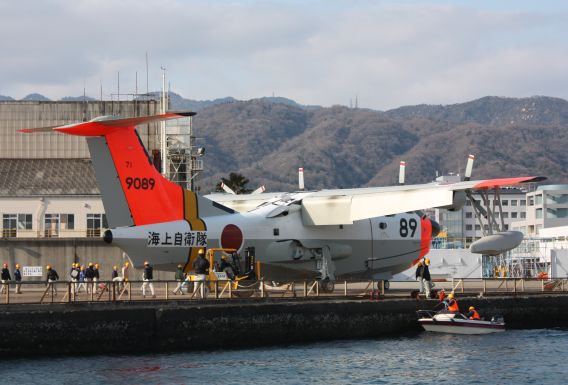 The aircraft’s engines windmilling, the ground crew moves into action. In the foreground, a forklift is driven into place to transport the “follow me” speedboat back into the hangar for storage.
The aircraft’s engines windmilling, the ground crew moves into action. In the foreground, a forklift is driven into place to transport the “follow me” speedboat back into the hangar for storage.
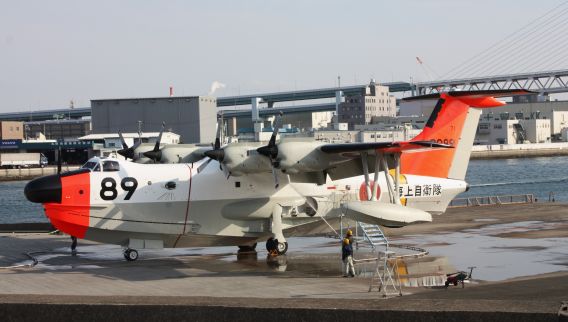
(Above and below) Two views of the aircraft during and after its post-flight wash down. As the Konan Plant lacks the automatic equipment embedded in taxiways at operational JMSDF bases, this
procedure has to be done by hand with hoses.
Parting Shot
 9089 can be made out in the distance on the right of this view. Above, traffic speeds along another Japanese engineering marvel, the Akashi-Kaikyo suspension bridge that connects the island of
9089 can be made out in the distance on the right of this view. Above, traffic speeds along another Japanese engineering marvel, the Akashi-Kaikyo suspension bridge that connects the island of
Awaji to Kobe on the mainland.
J-HangarSpace would like to extend thanks to all concerned at ShinMaywa and the Japan Aviation Journalists’ Association for granting such a rare opportunity. |
The Awaiting Fate?
 Having officially entered JMSDF service in March 2000, US-1A 9088 was engineless in a hangar at Iwakuni in September 2012. Now that 9088′ s flying days are over, only two aircraft of the type
Having officially entered JMSDF service in March 2000, US-1A 9088 was engineless in a hangar at Iwakuni in September 2012. Now that 9088′ s flying days are over, only two aircraft of the type
remain operational. Wishful thinking on the part of one JAJA member hoped that ShinMaywa
would splash out on some kind of permanent structure at the Konan Plant in which to
house a US-1A for posterity.
JGSDF Asaka Training Area
Asaka, Saitama Prefecture
October 27, 2013
J-HangarSpace was gratefully fortunate to obtain a ticket to witness the spectacle that is the annual review of Self-Defense Force (SDF) troops. Held on what was a glorious sunny day, this year it was the turn of the Japan Ground Self-Defense Force (JGSDF) to stage the event.
Event History
The first postwar review was held at what was then the Etchujima base in Tokyo in 1951—the year after the establishment of the National Police Reserve—and thus pre-dates the founding of the Self-Defense Forces. A ceremony that took place in front of the capital’s Meiji Memorial Picture Gallery in 1955 marked the first anniversary of the founding of the then Japan Defense Agency; this ceremony remained a fixture in the events diary until 1972.
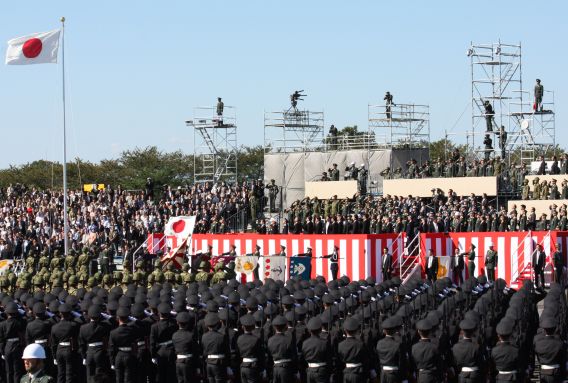 All present stand for the raising of the national flag at the 2013 SDF troop review.
All present stand for the raising of the national flag at the 2013 SDF troop review.
Ostensibly out of car parking and transport link considerations, the ceremony was moved to the Asaka Army Camp facility in 1973. Aside from 1988, when the Showa emperor died, and years in which there were large-scale disasters, this practice continued for the following eight years.
From 1996, the hosting military arm has followed a JASDF, JMSDF, JGSDF sequence, the latter missing its turn in 2001 as a result of the terrorist attacks against the United States. Favoured venue for the JASDF has been the hardly convenient Hyakuri AB out in Ibaraki Prefecture; in the case of the JMSDF the venue of choice has been Sagami Bay.
Acting as government host at this year’s event was Defense Minister Itsunori Onodera, who was appointed in December 2012. Prime Minister Shinzo Abe (pictured above) reviewed the 4,000-odd troops from a moving car before delivering a keynote speech from the main stand. As would be expected, security was tight both in and around the venue; police in riot gear had been positioned at every junction on the approach roads to the base.
 Defense Minister Itsunori Onodera (front right of stand) listens as
Defense Minister Itsunori Onodera (front right of stand) listens as
Prime Minister Abe delivers his speech.
In the space of about 90 minutes, a well-orchestrated and practiced sequence—rehearsals had been conducted on two previous days—saw serried ranks of SDF elements leave their initial parade positions to form at one end for the mass march past. These were followed by convoys involving around 240 military vehicles. The only change to the published programme (cover shown at top of this report) was the cancellation, due to the strong wind, of a parachute jump by airborne troops that had been planned to follow directly after the prime minister’s speech.
 Of aviation-related interest among the vehicles was this truck carrying the Fuji Heavy Industries-developed Forward Flying Observation System (FFOS). Having first entered production in
Of aviation-related interest among the vehicles was this truck carrying the Fuji Heavy Industries-developed Forward Flying Observation System (FFOS). Having first entered production in
2003, these helicopter-based unmanned aerial vehicles are operated in conjunction with
artillery units. Another example is seen below in a hangar at Kisarazu Army Camp.

Aviation content comprised a 50-aircraft flypast, led by formations of JGSDF helicopters by dint of hosting rights and their slower speed. Reported in the Japanese press as numbering around 20,000, spectators were mainly seated in long grandstand structures, positioned on either side of the parade ground and affording panoramic views. J-HangarSpace’s vantage point low in one stand opposite and to one side of the main stand was directly underneath the aircraft flight path, which was fortunately into the sun.
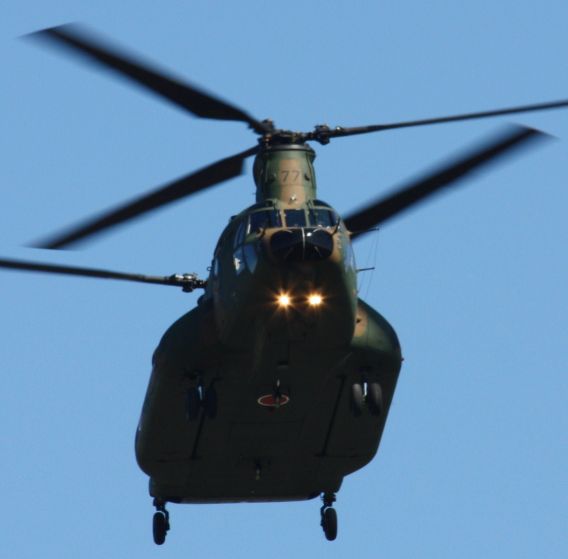 Five JGSDF Chinook helicopters participated in the mass flypast. A helicopter of this type transported Prime Minister Abe on his official visit to disaster-stricken Izu-Oshima later in the day.
Five JGSDF Chinook helicopters participated in the mass flypast. A helicopter of this type transported Prime Minister Abe on his official visit to disaster-stricken Izu-Oshima later in the day.
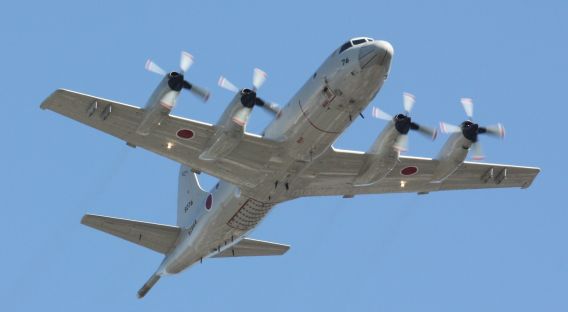 One of the three shiny P-3C patrol aircraft contributed by the JMSDF’s 2nd Fleet Air Squadron based at Hachinohe, Aomori Prefecture.
One of the three shiny P-3C patrol aircraft contributed by the JMSDF’s 2nd Fleet Air Squadron based at Hachinohe, Aomori Prefecture.
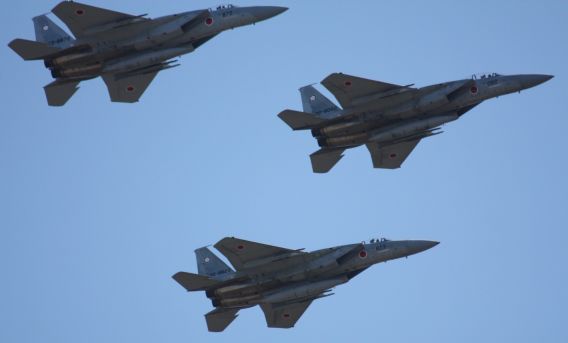 A trio of F-15J Eagle fighters from the 305th Squadron based at Hyakuri, the JASDF’s preferred venue when hosting the review ceremony.
A trio of F-15J Eagle fighters from the 305th Squadron based at Hyakuri, the JASDF’s preferred venue when hosting the review ceremony.
Following the lowering of the national flag and a salute in his honour, Prime Minister Abe departed. A supplementary programme of events, which included equipment displays and marching bands from the U.S. armed forces, kept the public entertained until the official closing time of 3 p.m.
That same afternoon, Prime Minister Abe changed from formal wear into more suitable garb before flying in a JGSDF Chinook helicopter to Izu-Oshima, one of the islands in the Tokyo-administered Izu chain around 100km south of the capital.
The island had borne the brunt of a typhoon 11 days before, and the resulting heavy rain and landslides had tragically claimed the lives of 31 islanders. In contrast to the spic and span precision of the review ceremony, JGSDF personnel had been heavily engaged in getting their hands dirty in the unenviable task of searching for those still missing and assisting in the clean-up operations, areas of expertise in which SDF personnel from all three services have gained more experience than they would have liked in recent years. Abe had made mention of the events on Izu-Oshima and paid tribute to the SDF’s tireless efforts at the start of his speech at Asaka.
Although come next October it should again fall to JASDF personnel at Hyakuri AB to host the event, it remains to be seen whether the 60th anniversary celebrations prompt a break with tradition.
Parting Shots
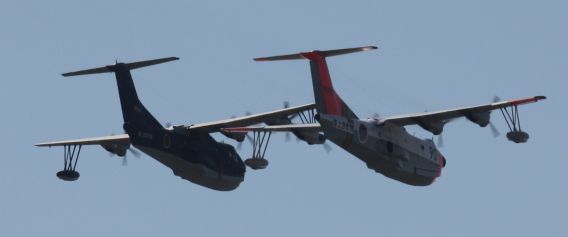 The ShinMaywa US-2 (left) and US-1A rescue amphibians fly off into the distance.
The ShinMaywa US-2 (left) and US-1A rescue amphibians fly off into the distance.
 Symmetry, SDF style (above). Women serving with the JGSDF demonstrate that they know how to
Symmetry, SDF style (above). Women serving with the JGSDF demonstrate that they know how to
work a runway.
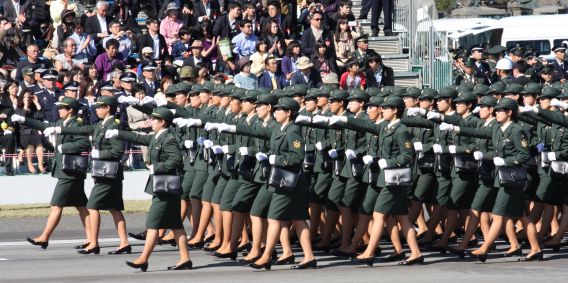
(In April 2014, J-HangarSpace returned to Asaka, which is also home to the JGSDF’s Public Information Center, to assist research into the service’s early years.)
Location Report 2
Gunma Heliport
Maebashi, Gunma Prefecture
September 14, 2013
 Gunma Heliport’s main terminal and administrative buildings feature distinctive yellow aerofoil designs on their roofs.
Gunma Heliport’s main terminal and administrative buildings feature distinctive yellow aerofoil designs on their roofs.
About an hour and a half by a bullet and local train north from Tokyo, the Gunma prefectural capital of Maebashi accounts for 340,000 of the administrative area’s total population of around two million.
Its name literally meaning ‘herd of horses’, Gunma is well known for agriculture and its history of sericulture. The Japanese aviation name most closely associated with the prefecture is that of Chikuhei Nakajima (1884–1949), who was himself from a local farming family. From humble beginnings in a shed that had been used for silkworm breeding in Ota, eastern Gunma, what became the Nakajima Aeroplane Company on April 1, 1918, went on to operate two plants in the prefecture, at Ota and Koizumi (now Ooizumi). The former site is now home to a plant belonging to Fuji Heavy Industries, Ltd., the Nakajima company’s postwar successor that produces cars under the Subaru brand name there; the latter houses Panasonic Group subsidiary Sanyo Semiconductor Co., Ltd.
The third public facility of its kind in the country, Gunma Heliport at Maebashi opened its doors on August 25, 1988, and is thus celebrating its 25th anniversary this year. In accordance with the designated administrator system included in a revision to the Local Government Act, the heliport has been under the management of a consortium made up of Japan Airport Consultants Inc. (JAC) and Taisei-Yuraku Real Estate Co., Ltd. since November 2007.
Taking a bus bound for Tamamura Town Hall from stop 4 on the north side of Maebashi station, Gunma Heliport is located about a five-minute walk from a bus stop of the same name. Covering 42,000 square metres (10.3 acres), the heliport has spaces marked out for seven helicopters on its apron; its operating hours are 0700–1900. It is equipped with a 55 metre × 30 metre (180 feet × 100 feet) landing strip and a 25 metre × 20 metre (82 feet × 65 feet) landing pad that can cater for helicopters up to the 9-ton class.
 A poster on a Gunma Heliport terminal building window advertises the events planned for Sora no Hi in the facility’s 25th year of operation.
A poster on a Gunma Heliport terminal building window advertises the events planned for Sora no Hi in the facility’s 25th year of operation.
J-HangarSpace’s visit coincided with festivities marking Sora no Hi, the generic name given to a wide range of aviation-related events held primarily at airports across Japan. Literally meaning Sky Day, Japanese sources still tend to use the previous Aviation Day, from Kokubi, when referring to such events in English. The Japanese name was changed in 1992, the 40th anniversary of the resumption of postwar civilian flying in Japan, from when the period September 20–30 has been known as Air Week.
Events planned during and around this period date back to the air pageant that took place at Tokyo’s Haneda Airport on September 28, 1940, to mark the 2,600th anniversary of the accession to the throne of Japan’s mythical founder, Emperor Jinmu, and the 30 years since the first successful flights in Japan made in heavier-than-air aircraft. (See the first entry on this website’s Japanese Aviation History page: click here) The following year, although the date itself had no special significance, the aviation authorities designated September 20 for a second Aviation Day, only for political events to intervene. Interrupted by the war and the postwar ban on flying, it was to be September 20, 1953, before Aviation Day could be resurrected.
Although on a lesser scale than other venues, Gunma Heliport’s six-hour Aviation Day schedule was a major attraction; a record-breaking 3,012 local residents attended. Aside from giving some of them—lucky lottery winners and paying passengers—their first experience of flight in a based operator’s helicopter, the Maebashi event gave the two resident units the opportunity to put their respective machines through spirited displays.
A hangar at the east end of the apron houses the Bell 412EP JA200G (‘G’ for Gunma and ‘200’ from the prefecture’s two million population, ‘200 ten thousands’ in the Japanese way of counting) belonging to the Gunma Prefectural Disaster Prevention Aviation Unit. Acquired for a then equipped price of around 700 million yen and handed over on May 20, 1997, the aircraft is called Haruna after Mount Haruna, a dormant volcano that lies within the prefecture. (An Imperial Japanese Navy [IJN] battleship and a now decommissioned class of JMSDF destroyer have also shared the name.)
Gunma Air Rescue, as they are known in English, share the heliport with the Gunma Prefectural Police Aviation Unit’s eight-seater Agusta 109E Power JA01GP, which is kept in a hangar adjacent to the terminal building. Like its predecessor, a Bell 206L-3 LongRanger, JA01GP is named Akagi, as Haruna after a local mountain. (Likewise, Akagi was also the name of an IJN ship, an aircraft carrier, in World War II.)
The A109E offers the benefit of more rapid response times to cover incidents within Gunma, for which centrally located Maebashi makes an ideal base. The Oze marshlands to the far northeast of Maebashi are less than 20 minutes’ flight time away, the city of Tatebayashi only 11 minutes to the southeast.
Details of the operations and equipment of these two units, and others like them, are planned for inclusion on their respective pages of this website.
 Haruna’s pilot brings her around to pick up a ‘casualty’ out on the airfield.
Haruna’s pilot brings her around to pick up a ‘casualty’ out on the airfield.
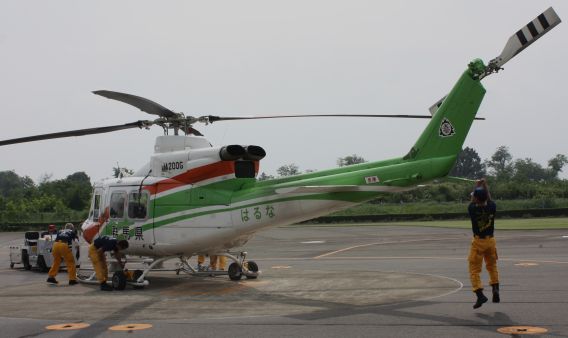 A crew member pulls down on Haruna’s tail bumper to raise the nose and enable the tow truck to be hooked up to the skids.
A crew member pulls down on Haruna’s tail bumper to raise the nose and enable the tow truck to be hooked up to the skids.
 Haruna’s tail marking comprises the symbol from the Gunma prefectural flag—a highly stylized representation of the kanji character for ‘gun’ in Gunma—superimposed within a fir tree design.
Haruna’s tail marking comprises the symbol from the Gunma prefectural flag—a highly stylized representation of the kanji character for ‘gun’ in Gunma—superimposed within a fir tree design.
(Above, left) Gunma Air Rescue busy at the office. The crew member in the centre is carrying a collapsible stretcher on his back. (Right) A Gunma Prefectural Police Aviation Unit crew member demonstrates his abseiling expertise.
 Acquired to replace a Bell 206L-3 LongRanger, Agusta A109E JA01GP has been in service since 2008. The two helicopters share the name Akagi, after a nearby mountain.
Acquired to replace a Bell 206L-3 LongRanger, Agusta A109E JA01GP has been in service since 2008. The two helicopters share the name Akagi, after a nearby mountain.
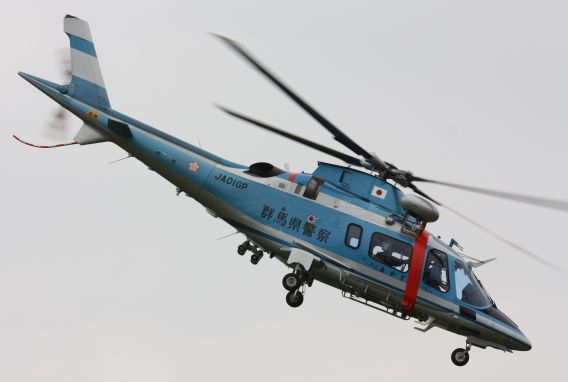 Gunma Prefectural Police Aviation Unit commander Hideto Hagiwara puts the nose down to gain speed prior to putting Akagi through her paces on a demonstration flight.
Gunma Prefectural Police Aviation Unit commander Hideto Hagiwara puts the nose down to gain speed prior to putting Akagi through her paces on a demonstration flight.
Gunma Heliport Study Room & Resource Center
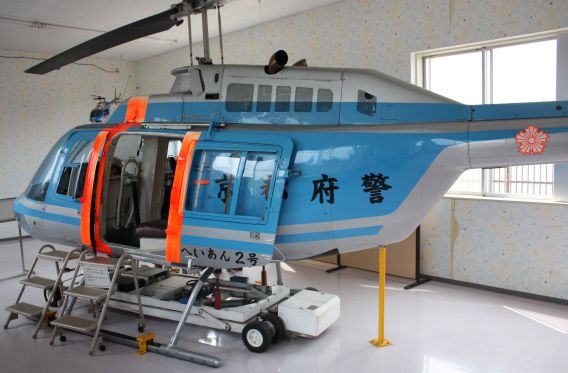 (Above and below) In addition to the terminal building, administrative offices, fuel facility and four hangars, Gunma Heliport has housed former Kyoto Police Bell 206B JetRanger JA9092, named
(Above and below) In addition to the terminal building, administrative offices, fuel facility and four hangars, Gunma Heliport has housed former Kyoto Police Bell 206B JetRanger JA9092, named
Heian 2—acquired in October 1995—in a study room and resource center that was opened in
March 1997. This section of the building is open daily and featured on conducted tours.

Parting Shots
 The up-and-coming stars of the Aviation Day festival, Akagi and Haruna
The up-and-coming stars of the Aviation Day festival, Akagi and Haruna
 Her work hopefully done for the day, Haruna sits outside the Gunma Prefectural Disaster Prevention Aviation Unit’s very own hangar space.
Her work hopefully done for the day, Haruna sits outside the Gunma Prefectural Disaster Prevention Aviation Unit’s very own hangar space.
Location Report 1
Aircraft Division, ShinMaywa Industries, Ltd.
Konan Plant, Kobe, Hyogo Prefecture
August 29, 2013
 The second prototype Shin Maywa US-2 search and rescue amphibian is dwarfed by the cavernous hangar at the company’s Konan Plant in Kobe, August 29, 2013.
The second prototype Shin Maywa US-2 search and rescue amphibian is dwarfed by the cavernous hangar at the company’s Konan Plant in Kobe, August 29, 2013.
Representative of this website’s planned content, the first J-HangarSpace location report comes to you from ShinMaywa’s main plant in Kobe, where each of the company’s postwar family of JMSDF aircraft—the PS-1 anti-submarine warfare (ASW) flying boat and the US-1/US-1A as well as US-2 search and rescue (SAR) amphibians—has been developed and manufactured.
J-HangarSpace joined a tour organized by the Japan Aviation Journalists’ Association (JAJA) to gain more of an insight into the company and the US-2, the second prototype of which was present in the hangar.
Background to Konan Plant
Squeezed in between the main highway connecting Kobe with Osaka and the edge of Kobe Bay, the Konan Plant is located close to Ashiya station on Japan Railway’s Kobe Line. The plant’s operations date back to 1942 and the era of Kawanishi Aircraft Company Limited, ShinMaywa’s famous predecessor. From before the Pacific War, Kawanishi’s operations had centered on the manufacture of floatplanes and flying boats, culminating with its Type 2 Flying Boat (Emily), 167 of which were built here. A close look at the front of the hangar reveals the patches covering the holes made by a marauding U.S. Navy F6F Hellcat pilot in the closing stages of the war.
In the immediate postwar era, the Allied Occupation authorities imposed a ban on aircraft manufacture that was to last until April 1952. Founded in 1949, Shin Meiwa Industry Co., Ltd. (the name was anglicized to ShinMaywa in 1960) turned Kawanishi’s technological skills to the production of motorcycles and dump trucks. Soon after the outbreak of the Korean War in June 1950, the company received contracts to manufacture drop tanks for U.S. Air Force aircraft and moved on to overhauls of the nascent Japan Air Self-Defense Force’s Sikorsky S-51 helicopters from September 1954. Nowadays, the company is responsible for overhauling JASDF U-4 (Grumman Gulfstream IV SP) and JMSDF U-36A (Learjet 36A) aircraft.
A Hitachi Group affiliate company from 1960 to 2004, the company’s history of diversification persists to this day. Including special-purpose truck bodies, car parking systems and passenger boarding bridges for airports, its current product range extends across four other business divisions.
In the 1960s, the Konan Plant carried out overhauls of the U.S. Navy’s Pacific-based fleet of twin-engined Martin P5M Mariner patrol seaplanes, a type that bears a certain similarity to the Japanese designs. The company’s wealth of experience in the design and manufacture of flying boats made it the ideal contractor for the task. To this day, the plant features a slipway located a short distance away from the apron in front of the main hangar; aircraft can thus undergo on-the-spot water taxying and flight trials.
The Konan Plant’s 116,725 square metre (29-acre) area is roughly three times the size of the local Hanshin Tigers baseball stadium. These days, much of the plant is devoted to the manufacture of composite material components for Airbus and Boeing airliners. Employing a workforce of just over 1,000 people, the Aircraft Division also operates plants at Takurazuka in Hyogo Prefecture (for component assembly) and at Tokushima on the island of Shikoku.
 The unassuming entrance to the Aircraft Division’s main technical block
The unassuming entrance to the Aircraft Division’s main technical block
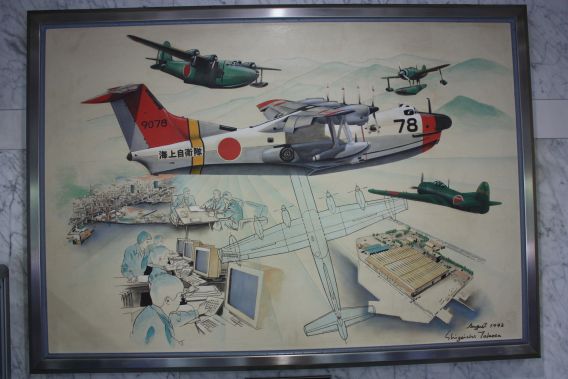 Commissioned to mark the 1992 first anniversary of the technical block’s completion, the artwork hanging in the building’s foyer includes Kawanishi aircraft and a ShinMaywa US-1A
Commissioned to mark the 1992 first anniversary of the technical block’s completion, the artwork hanging in the building’s foyer includes Kawanishi aircraft and a ShinMaywa US-1A
with Mt. Rokko, a Kobe landmark, in the distance.
Highly Qualified Host
The factory tour group were honoured to have as principal host none other than ShinMaywa test pilot Yoshimasa Miyamoto. Born in Kyoto in 1949, he was assigned to Iwakuni in Yamaguchi Prefecture after graduation from the JMSDF’s Naval Academy in Etajima, Hiroshima Prefecture. Miyamoto’s career path followed exclusively the progression of ShinMaywa types with the 31st Fleet Air Group’s 71st Fleet Air Squadron at Iwakuni. He had amassed around 2,800 hours on the PS-1 and 6,000 hours on the US-1/US-1A by the time of his retirement from the JMSDF, when he joined ShinMaywa as chief test pilot on the US-1AKai (Improved) programme, the designation by which the US-2 was originally known.
Miyamoto introduced a JMSDF-produced video that ran through a typical US-2 SAR mission and the technology that lies at the crew’s disposal. This includes a retractable Mitsubishi Electric forward-looking infra-red (FLIR) camera mounted on a swivel turret in the port side of the nose, the feed from which can be displayed directly in front of the pilots.
In the video, a co-pilot who had formerly flown the P-3C Orion was still coming to grips with landing on the shifting sea instead of a firm runway. To assist transitioning pilots, Iwakuni operates a US-2 simulator that J-HangarSpace briefly “flew” last year, finding the visual system very rudimentary in comparison with airliner simulators. A ShinMaywa engineer said that budgetary constraints would not have permitted anything other than the bare essentials.
US-2 Development Priorities
Hideyuki Mochida, a manager in the ShinMaywa Aircraft Division’s Engineering Department, kindly provided the attendees with an overview of the US-2’s development from the US-1A.
Although only seven years had separated in turn the 1967-vintage PS-1 from the US-1 (1974) and US-1A (1981), some 15 years had passed when development of what was to become the US-2 was commenced in 1996. Another six years were to elapse before the first prototype’s completion on November 28, 2002.
Taking into account the advances in technology that had been made in the ensuing period, the engineers’ brief ultimately led them to focus on implementing improvements in three principal areas:
(i) Handling when taking off or landing on water
Fly-by-wire technology with manual backup was adopted for the flight controls and “glass cockpit” instrumentation installed.
(ii) The on-board environment for patients
A pressurized cabin was introduced, enabling higher altitude ferry operations.
(iii) Open-ocean rescue capabilities
The US-1A’s four 3,400shp Allison T64 engines, licence-built in Japan by IHI, and three-blade propellers were replaced by 4,591shp Rolls-Royce AE2100Js driving six-blade Dowty units.
 Seen from the co-pilot’s seat, the captain’s dual-screen glass cockpit follows the standard configuration of primary flight (left) and navigation displays. Centrally mounted are the large-screen engine (top) and systems displays. To the lower left of the latter, which also shows checklists, is the flight control display that provides rudder angle and trim status information. Although some pilots are qualified to fly both the US-1A and the US-2, they tend to be assigned to operate only one of the types due to the inherent differences in the cockpit instrumentation and flight control systems.
Seen from the co-pilot’s seat, the captain’s dual-screen glass cockpit follows the standard configuration of primary flight (left) and navigation displays. Centrally mounted are the large-screen engine (top) and systems displays. To the lower left of the latter, which also shows checklists, is the flight control display that provides rudder angle and trim status information. Although some pilots are qualified to fly both the US-1A and the US-2, they tend to be assigned to operate only one of the types due to the inherent differences in the cockpit instrumentation and flight control systems.
 The US-2’s Dowty R414 propellers are 4.12m (13.5 ft) in diameter and each weighs 393kg (around 870lbs), making them smaller but heavier than those fitted to the US-1A.
The US-2’s Dowty R414 propellers are 4.12m (13.5 ft) in diameter and each weighs 393kg (around 870lbs), making them smaller but heavier than those fitted to the US-1A.
The aircraft’s fifth engine, a vertically oriented Honeywell/Rolls-Royce CTS800-4K helicopter engine embedded in the upper fuselage aft of the main wing, has been retained to provide power solely to the boundary layer control (BLC) system. Blowing air over the aircraft’s rudder, flaps and elevators plays a major part in reducing the aircraft’s takeoff and landing speed from that of a normal aircraft, which at 300 km/h (185mph) equals that of a bullet train, to that of a car (around 90km/h, 55mph). In passing, it was mentioned that the US-2 is not equipped with an anti-skid system for landings on wet or icy runways.
Overall, the improvements made resulted in the US-2 being able to reach a search area more quickly and loiter on station longer. The aircraft’s maximum radius of operation with two hours spent on station was extended to 1,000 nautical miles (1,850km), a 25% improvement on that of the US-1A. At a landing weight of 43 tons, the aircraft’s extremely low landing speed characteristics allow it come to a gently bobbing halt after only 330m (1,080 feet) on the ocean, from which takeoff can be achieved in 280 metres (920 feet). To cap it all, depending on the length of the waves, the US-2 is also uniquely capable of operating in ocean swell up to 3m (10ft), around double a flying boat’s normal operating limit.
| US-1A/US-2 Rescue Mission Record (as at July 31, 2013) | ||
| Mission Type | No. of Missions | No. of Persons Rescued |
| Ferrying of patients | 740 | 798 |
| Open-ocean rescue | 155 | 133 |
| Other | 71 | 20 |
| Total: | 966 | 951 |
| Data kindly supplied by ShinMaywa Industries, Ltd. | ||
Design Comparison
A walk around the second prototype allowed a closer look at the changes made to the US-1A’s external appearance to arrive at the current version. The US-1A’s nose underwent some cosmetic surgery to make the US-2’s radome that much smaller, and the earlier aircraft’s oversized sensor antenna positioned directly in front of the cockpit was deleted. The US-2 also lacks the canted fences that had to be installed atop its predecessors’ engine nacelles to rectify a marked propwash-induced sideslip. Whereas the fuselages of the earlier aircraft ended in a tail cone, from which protrudes a refueling inlet, the US-2’s fuselage has been shortened and ends flush with the trailing edge of the rudder. More subtle changes involved smoothing out the fuselage line aft of the cockpit and the hull fairing aft of the wing as well as enlarging and repositioning further forward the bulged window on each side of the forward fuselage.
A close look at a photo of the port side of the dorsal fin of a US-1A will reveal a round grille opening within the yellow stripe. Omitted from the US-2, this houses a speaker, via which the pilot or co-pilot can be in vocal contact with persons being rescued while circling above or after landing.
The decision to install cabin pressurization along two-thirds of the cabin length resulted in exhaustive efforts to save weight elsewhere. Including the use of alloy materials for the wing floats and titanium for parts of the main undercarriage and the front panel of the spray suppression device, these efforts resulted in the trimming off of 600kg.
The US-2 retains two examples of ShinMaywa’s proprietary expertise in the field of hydrodynamics that were featured on its predecessor and are instrumental in its ocean landing and takeoff performance: the U-shaped groove-type spray suppression device wrapped around the nose that channels the water flow downwards, and a pair of convex-shaped spray spoilers that have been fitted under the fuselage to then direct the water flow sideways. The latter minimize the likelihood of an engine ingesting salt water or that the propellers and wing will sustain wave damage. Interestingly, upon its return from an over-water mission, a US-2’s engines are stopped and the aircraft pulled by a tow-truck through a water spray system embedded in a taxiway to blast off any salt deposits; the standard anti-corrosion procedure for a P-3C Orion patrol aircraft is to be slowly taxied under its own power through the jets of water.
 Combined with its low landing speed, the US-2’s narrow boat hull lessens the impact of ocean landings. This imposing head-on view shows the multiple attachment points of the groove-type spray suppression device to good advantage. Known as the nose pendant, the rope on the nose is used for mooring purposes in conjunction with the anchor stowed on board.
Combined with its low landing speed, the US-2’s narrow boat hull lessens the impact of ocean landings. This imposing head-on view shows the multiple attachment points of the groove-type spray suppression device to good advantage. Known as the nose pendant, the rope on the nose is used for mooring purposes in conjunction with the anchor stowed on board.
 A ShinMaywa engineer checks the drain hole at the rear of the groove-type spray suppression device.
A ShinMaywa engineer checks the drain hole at the rear of the groove-type spray suppression device.
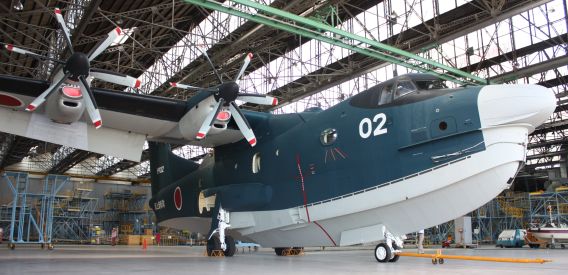 J-HangarSpace had been hoping to make a major splash with close-up shots of 9902 on takeoff from and landing on Kobe Bay; unfortunately, technical hitches on the day dictated that she never moved an inch, let alone got her feet wet.
J-HangarSpace had been hoping to make a major splash with close-up shots of 9902 on takeoff from and landing on Kobe Bay; unfortunately, technical hitches on the day dictated that she never moved an inch, let alone got her feet wet.
 The US-2 amphibian’s mainwheels and complex retraction mechanism are a far cry from the single wheel units of its ‘grandfather’, the PS-1 flying boat. As the latter was not designed and did not have the capability to land on runways, its mainwheels—akin to built-in beaching gear—were actually the
The US-2 amphibian’s mainwheels and complex retraction mechanism are a far cry from the single wheel units of its ‘grandfather’, the PS-1 flying boat. As the latter was not designed and did not have the capability to land on runways, its mainwheels—akin to built-in beaching gear—were actually the
same as those fitted on the Lockheed F-104J Starfighter.
US-2 Programme Status
December 18, 2013, will mark the 10th anniversary of the first flight of the ShinMaywa US-1Kai (US-2). Including the two prototypes, five* are currently in service with the JMSDF alongside two of the US-2’s predecessor, the US-1A. Plans call for a total fleet of 14 US-2s and the retirement of the last of the US-1As when they achieve their airframe flight hour limit, which will likely occur within the next four years.
The Konan Plant undertakes the final assembly of a “Tamiya kit” of major assemblies and components provided by the participation of around 1,500 companies. Shin Maywa itself produces the radome, forward section of the boat hull, nosewheel undercarriage and door, main undercarriage, wing floats and rear fuselage. As tends to be the case, other famous names in Japan’s aviation industry have a stake in the production of other major sub-assemblies, which are transported by road to Kobe. Prominent among the other suppliers are:
| Company Name | Major Assemblies |
| Kawasaki Heavy Industries (KHI) | Cockpit and pressurized section of forward fuselage; centre section of the main wing; vertical tail |
| Mitsubishi Heavy Industries (MHI) | Outer sections of main wing, rear sections of engine nacelles, horizontal tail assembly, rudder |
| NIPPI Corporation (KHI subsidiary) |
Wave suppression device; fuselage-side undercarriage bulges; rear fuselage door; forward sections of engine nacelles; forward and aft main wing fairings; wing slats, spoilers and inner/outer flaps; dorsal fin |
If all goes according to plan the Konan assembly line will see unprecedented activity, as the US-2 is in line to become the first civil version of an SDF aircraft type to be exported. Involving the thrashing out of an offset agreement, negotiations are still under way with the Indian government. In the meantime, ShinMaywa will be building the sixth US-2 under a 12.3 billion yen contract awarded under the fiscal 2013 budget.
The latter part of ShinMaywa’s presentation focused on the aircraft’s much-touted but cost-prohibitive civil application as a water bomber, a plan that dates back to June 1976, when drop trials were carried out at Iwakuni with the suitably modified first prototype PS-1 ASW aircraft. An ideal but technically challenging solution would be for the JMSDF to operate a small number of quick-change versions of the aircraft, although a suggestion from the floor was for US-2 operations to be progressively handed over to the Japan Coast Guard, as they were no longer best suited to the JMSDF’s remit.
J-HangarSpace’s visit was to have included boarding a boat to witness the second prototype’s last test flight before being handed back to the JMSDF for service with the 71st Fleet Air Squadron at Iwakuni. Sadly, technical problems meant that the flight had to be postponed to a later date.
(*) Reduced to four after one aircraft was involved in a non-fatal accident on April 28, 2015. (See the JMSDF Aircraft Programmes page)
| Acknowledgements J-HangarSpace gratefully acknowledges the assistance of all the ShinMaywa personnel who generously gave of their time to make the visit so informative and enjoyable. Thanks must also be extended to the JAJA organizers, particularly Executive Director Yukio Suzuki, whose drawings grace the Famous Airplanes of the World series books devoted to the ShinMaywa PS-1 (No. 139) and US-1 (No. 140) that are published (in Japanese only) by Bunrindo. |
Photo Gallery: US-2 Interior
As the second prototype was at the end of a flight test programme, during which additional technical data was gathered, its on-board equipment fit was in the process of reverting back to that of the production aircraft. Working backwards from the flight deck, these images thus give a fair representation of an operational aircraft’s interior, though layouts do vary depending on the type of rescue mission being conducted. If the need arises, up to 30 passengers can be accommodated, or 11 stretchers when in dedicated rescue configuration. As an airlifter, the US-2 can carry a maximum payload of 3 tons.
The flight deck extends up to frame 11, the accommodation quarters from there to frame 24 (a distance of 13m [42.6ft]), and the crew room between frames 24 and 31, the latter marking the end of the pressurized cabin area.
Flight Deck
 The intense glare of the sun through the windscreens made it difficult to include the overhead panel in this general view of the flight deck.
The intense glare of the sun through the windscreens made it difficult to include the overhead panel in this general view of the flight deck.
 The co-pilot’s nosewheel steering control can be seen to the immediate right of the control column. Changes of direction up to a maximum of 60 degrees to the left or right are possible.
The co-pilot’s nosewheel steering control can be seen to the immediate right of the control column. Changes of direction up to a maximum of 60 degrees to the left or right are possible.
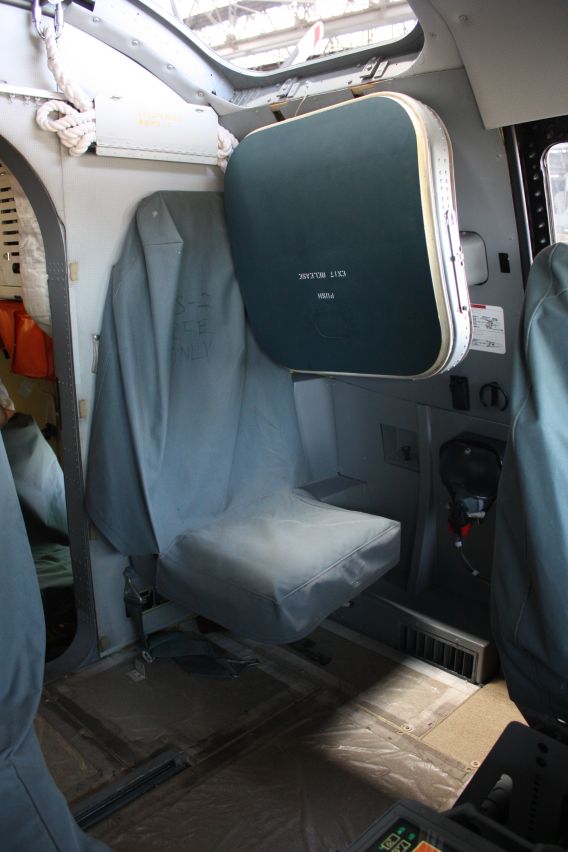 The port overhead cockpit escape hatch had been lowered to provide additional ventilation on what was a baking hot day in Kobe. Giving the aircraft a just moved in look, many of the seats were
The port overhead cockpit escape hatch had been lowered to provide additional ventilation on what was a baking hot day in Kobe. Giving the aircraft a just moved in look, many of the seats were
protected by grey covers, most of which had handwritten marks showing their designated positions.
Accommodation Quarters
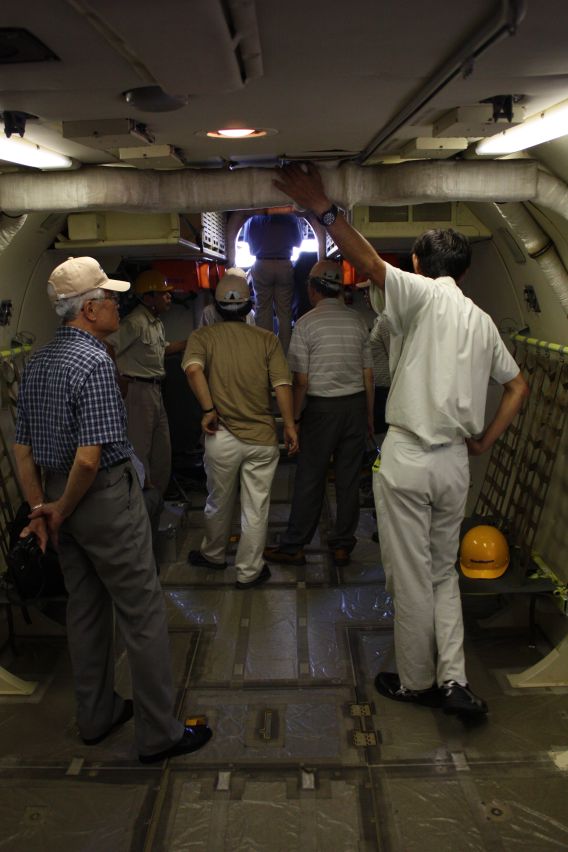 ShinMaywa personnel show the JAJA group around the US-2’s flight deck and still spartanly appointed accommodation quarters. Configurations vary, but the US-2’s accommodation quarters are normally configured with foldable, inward-facing troop seating arranged along the port side and stretchers
ShinMaywa personnel show the JAJA group around the US-2’s flight deck and still spartanly appointed accommodation quarters. Configurations vary, but the US-2’s accommodation quarters are normally configured with foldable, inward-facing troop seating arranged along the port side and stretchers
on the starboard side.
 The hatch leading down to the nose compartment had been ‘invitingly’ left open.
The hatch leading down to the nose compartment had been ‘invitingly’ left open.
 The escape hatch next to the starboard observation station—located midships, beneath the leading edge of the main wing—had been removed and placed on the seat.
The escape hatch next to the starboard observation station—located midships, beneath the leading edge of the main wing—had been removed and placed on the seat.
Crew Room
 The crew room area, looking back from the accommodation quarters. The far door, forward of the orange seat, marks the end of the pressurized cabin.
The crew room area, looking back from the accommodation quarters. The far door, forward of the orange seat, marks the end of the pressurized cabin.
 A US-2’s crew complement varies but usually numbers 11: two pilots, two flight engineers, an SAR coordinator, an electronic sensor operator—whose station, shown here, is on the starboard side
A US-2’s crew complement varies but usually numbers 11: two pilots, two flight engineers, an SAR coordinator, an electronic sensor operator—whose station, shown here, is on the starboard side
of the crew room—two flight medics and a three-man rescue team, including a JMSDF diver.
 The SAR coordinator’s seat is located on the port side of the crew room.
The SAR coordinator’s seat is located on the port side of the crew room.
Nonpressurized Operations Deck
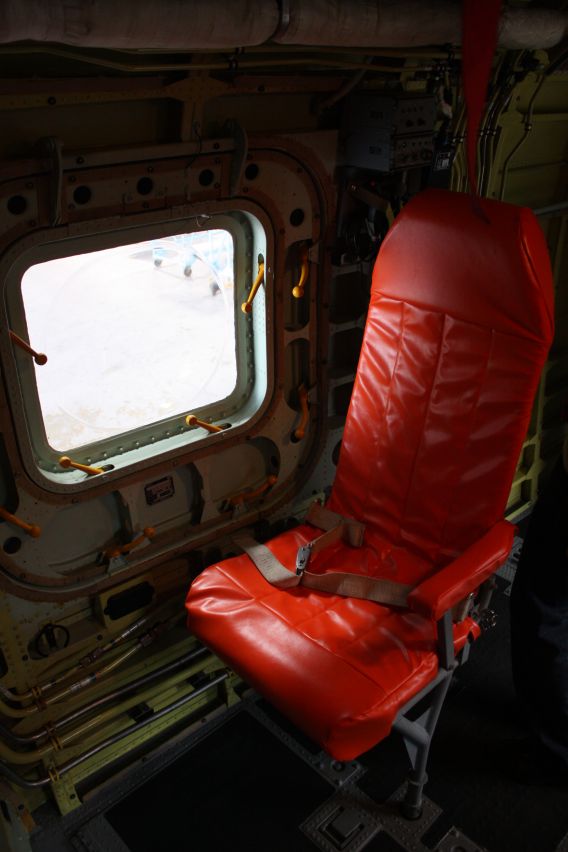 Only two-thirds of the length of the cabin is pressurized, so this seat on the opposite side to and a little forward of the main fuselage door lies outside that zone.
Only two-thirds of the length of the cabin is pressurized, so this seat on the opposite side to and a little forward of the main fuselage door lies outside that zone.
 ShinMaywa craftsmanship is seen in this exposed section of fuselage opposite the main fuselage door.
ShinMaywa craftsmanship is seen in this exposed section of fuselage opposite the main fuselage door.
 Incorporating a collapsible seat in its stowed position, the cargo-like main fuselage door opens inwards and is slid sideways and locked in position to maximize space. In a rescue situation on the high seas, rapidly deploying the inflatable, outboard motor-powered rescue dinghy in the confined space
Incorporating a collapsible seat in its stowed position, the cargo-like main fuselage door opens inwards and is slid sideways and locked in position to maximize space. In a rescue situation on the high seas, rapidly deploying the inflatable, outboard motor-powered rescue dinghy in the confined space
available demands precise and practised teamwork.
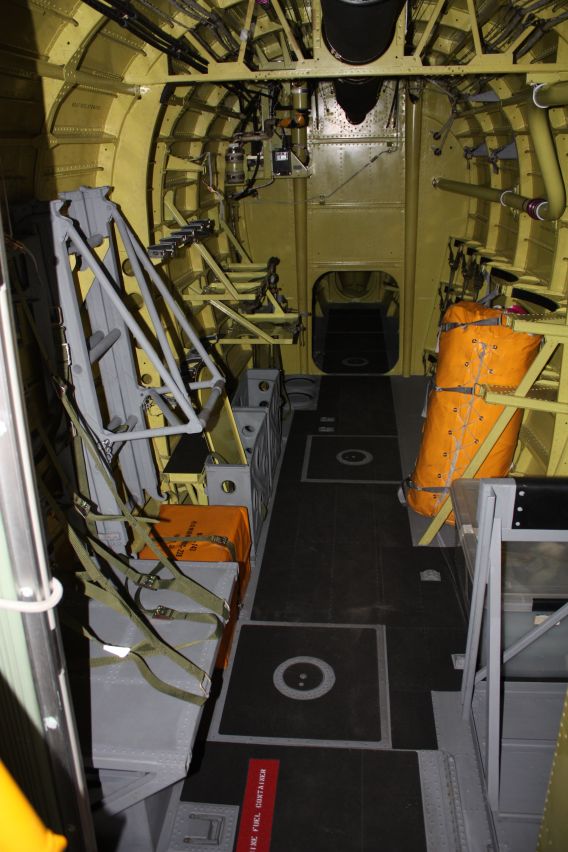 The area at the very rear contains more seating and stowage space. The black ducting running along the centre of the cabin roof forms part of the BLC system.
The area at the very rear contains more seating and stowage space. The black ducting running along the centre of the cabin roof forms part of the BLC system.
Parting Shots
 This view clearly shows the strake-like, convex-shaped spray spoiler, which directs the water flow sideways, located on the underside of the boat hull just aft of the red propeller warning stripe.
This view clearly shows the strake-like, convex-shaped spray spoiler, which directs the water flow sideways, located on the underside of the boat hull just aft of the red propeller warning stripe.
The lines radiating down from the bulged side window are used according to the surface
wind speed when air-dropping supplies. From the left, each pair of red and yellow
stripes represents a 10-knot increase in wind speed, starting with 0 knots.
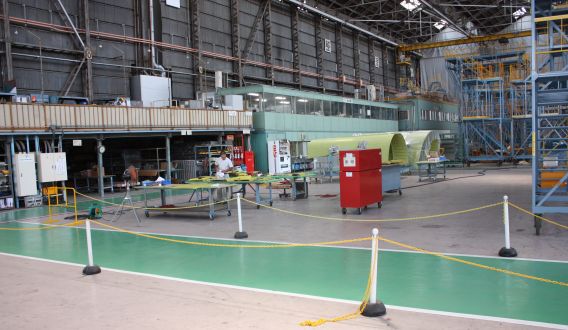 The JAJA group was shown a small but key part of the Konan Plant. If the Indian contract negotiations are successfully concluded, this assembly hangar will again be bustling with activity.
The JAJA group was shown a small but key part of the Konan Plant. If the Indian contract negotiations are successfully concluded, this assembly hangar will again be bustling with activity.


